Neural network method for extraction evaluation rules of soil fertility Abstract
- 格式:pdf
- 大小:154.68 KB
- 文档页数:5
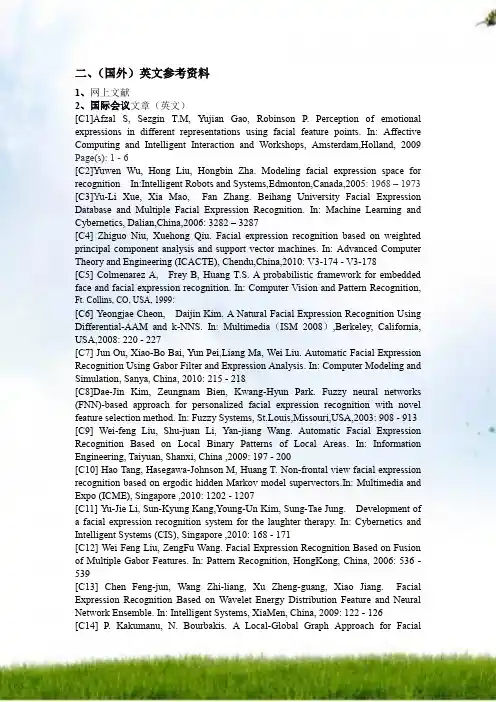
二、(国外)英文参考资料1、网上文献2、国际会议文章(英文)[C1]Afzal S, Sezgin T.M, Yujian Gao, Robinson P. Perception of emotional expressions in different representations using facial feature points. In: Affective Computing and Intelligent Interaction and Workshops, Amsterdam,Holland, 2009 Page(s): 1 - 6[C2]Yuwen Wu, Hong Liu, Hongbin Zha. Modeling facial expression space for recognition In:Intelligent Robots and Systems,Edmonton,Canada,2005: 1968 – 1973 [C3]Y u-Li Xue, Xia Mao, Fan Zhang. Beihang University Facial Expression Database and Multiple Facial Expression Recognition. In: Machine Learning and Cybernetics, Dalian,China,2006: 3282 – 3287[C4] Zhiguo Niu, Xuehong Qiu. Facial expression recognition based on weighted principal component analysis and support vector machines. In: Advanced Computer Theory and Engineering (ICACTE), Chendu,China,2010: V3-174 - V3-178[C5] Colmenarez A, Frey B, Huang T.S. A probabilistic framework for embedded face and facial expression recognition. In: Computer Vision and Pattern Recognition, Ft. Collins, CO, USA, 1999:[C6] Yeongjae Cheon, Daijin Kim. A Natural Facial Expression Recognition Using Differential-AAM and k-NNS. In: Multimedia(ISM 2008),Berkeley, California, USA,2008: 220 - 227[C7]Jun Ou, Xiao-Bo Bai, Yun Pei,Liang Ma, Wei Liu. Automatic Facial Expression Recognition Using Gabor Filter and Expression Analysis. In: Computer Modeling and Simulation, Sanya, China, 2010: 215 - 218[C8]Dae-Jin Kim, Zeungnam Bien, Kwang-Hyun Park. Fuzzy neural networks (FNN)-based approach for personalized facial expression recognition with novel feature selection method. In: Fuzzy Systems, St.Louis,Missouri,USA,2003: 908 - 913 [C9] Wei-feng Liu, Shu-juan Li, Yan-jiang Wang. Automatic Facial Expression Recognition Based on Local Binary Patterns of Local Areas. In: Information Engineering, Taiyuan, Shanxi, China ,2009: 197 - 200[C10] Hao Tang, Hasegawa-Johnson M, Huang T. Non-frontal view facial expression recognition based on ergodic hidden Markov model supervectors.In: Multimedia and Expo (ICME), Singapore ,2010: 1202 - 1207[C11] Yu-Jie Li, Sun-Kyung Kang,Young-Un Kim, Sung-Tae Jung. Development of a facial expression recognition system for the laughter therapy. In: Cybernetics and Intelligent Systems (CIS), Singapore ,2010: 168 - 171[C12] Wei Feng Liu, ZengFu Wang. Facial Expression Recognition Based on Fusion of Multiple Gabor Features. In: Pattern Recognition, HongKong, China, 2006: 536 - 539[C13] Chen Feng-jun, Wang Zhi-liang, Xu Zheng-guang, Xiao Jiang. Facial Expression Recognition Based on Wavelet Energy Distribution Feature and Neural Network Ensemble. In: Intelligent Systems, XiaMen, China, 2009: 122 - 126[C14] P. Kakumanu, N. Bourbakis. A Local-Global Graph Approach for FacialExpression Recognition. In: Tools with Artificial Intelligence, Arlington, Virginia, USA,2006: 685 - 692[C15] Mingwei Huang, Zhen Wang, Zilu Ying. Facial expression recognition using Stochastic Neighbor Embedding and SVMs. In: System Science and Engineering (ICSSE), Macao, China, 2011: 671 - 674[C16] Junhua Li, Li Peng. Feature difference matrix and QNNs for facial expression recognition. In: Control and Decision Conference, Yantai, China, 2008: 3445 - 3449 [C17] Yuxiao Hu, Zhihong Zeng, Lijun Yin,Xiaozhou Wei, Jilin Tu, Huang, T.S. A study of non-frontal-view facial expressions recognition. In: Pattern Recognition, Tampa, FL, USA,2008: 1 - 4[C18] Balasubramani A, Kalaivanan K, Karpagalakshmi R.C, Monikandan R. Automatic facial expression recognition system. In: Computing, Communication and Networking, St. Thomas,USA, 2008: 1 - 5[C19] Hui Zhao, Zhiliang Wang, Jihui Men. Facial Complex Expression Recognition Based on Fuzzy Kernel Clustering and Support Vector Machines. In: Natural Computation, Haikou,Hainan,China,2007: 562 - 566[C20] Khanam A, Shafiq M.Z, Akram M.U. Fuzzy Based Facial Expression Recognition. In: Image and Signal Processing, Sanya, Hainan, China,2008: 598 - 602 [C21] Sako H, Smith A.V.W. Real-time facial expression recognition based on features' positions and dimensions. In: Pattern Recognition, Vienna,Austria, 1996: 643 - 648 vol.3[C22] Huang M.W, Wang Z.W, Ying Z.L. A novel method of facial expression recognition based on GPLVM Plus SVM. In: Signal Processing (ICSP), Beijing, China, 2010: 916 - 919[C23] Xianxing Wu; Jieyu Zhao; Curvelet feature extraction for face recognition and facial expression recognition. In: Natural Computation (ICNC), Yantai, China, 2010: 1212 - 1216[C24]Xu Q Z, Zhang P Z, Yang L X, et al.A facial expression recognition approach based on novel support vector machine tree. In Proceedings of the 4th International Symposium on Neural Networks, Nanjing, China, 2007: 374-381.[C25] Wang Y B, Ai H Z, Wu B, et al. Real time facial expression recognition with adaboost.In: Proceedings of the 17th International Conference on Pattern Recognition , Cambridge,UK, 2004: 926-929.[C26] Guo G, Dyer C R. Simultaneous feature selection and classifier training via linear programming: a case study for face expression recognition. In: Proceedings of the 2003 IEEE Computer Society Conference on Computer Vision and Pattern Recognition, Madison, W isconsin, USA, 2003,1: 346-352.[C27] Bourel F, Chibelushi C C, Low A A. Robust facial expression recognition using a state-based model of spatially-localised facial dynamics. In: Proceedings of the 5th IEEE International Conference on Automatic Face and Gesture Recognition, Washington, DC, USA, 2002: 113-118·[C28] Buciu I, Kotsia I, Pitas I. Facial expression analysis under partial occlusion. In: Proceedings of the 2005 IEEE International Conference on Acoustics, Speech, and Signal Processing, Philadelphia, PA, USA, 2005,V: 453-456.[C29] ZHAN Yong-zhao,YE Jing-fu,NIU De-jiao,et al.Facial expression recognition based on Gabor wavelet transformation and elastic templates matching. Proc of the 3rd International Conference on Image and Graphics.Washington DC, USA,2004:254-257.[C30] PRASEEDA L V,KUMAR S,VIDYADHARAN D S,et al.Analysis of facial expressions using PCA on half and full faces. Proc of ICALIP2008.2008:1379-1383.[C31] LEE J J,UDDIN M Z,KIM T S.Spatiotemporal human facial expression recognition using Fisher independent component analysis and Hidden Markov model [C]//Proc of the 30th Annual International Conference of IEEE Engineering in Medicine and Biology Society.2008:2546-2549.[C32] LITTLEWORT G,BARTLETT M,FASELL. Dynamics of facial expression extracted automatically from video. In: Proceedings of IEEE Conference on Computer Vision and Pattern Recognition, Workshop on Face Processing inVideo, Washington DC,USA,2006:80-81.[C33] Kotsia I, Nikolaidis N, Pitas I. Facial Expression Recognition in Videos using a Novel Multi-Class Support Vector Machines Variant. In: Acoustics, Speech and Signal Processing, Honolulu, Hawaii, USA, 2007: II-585 - II-588[C34] Ruo Du, Qiang Wu, Xiangjian He, Wenjing Jia, Daming Wei. Facial expression recognition using histogram variances faces. In: Applications of Computer Vision (WACV), Snowbird, Utah, USA, 2009: 1 - 7[C35] Kobayashi H, Tange K, Hara F. Real-time recognition of six basic facial expressions. In: Robot and Human Communication, Tokyo , Japan,1995: 179 - 186 [C36] Hao Tang, Huang T.S. 3D facial expression recognition based on properties of line segments connecting facial feature points. In: Automatic Face & Gesture Recognition, Amsterdam, The Netherlands, 2008: 1 - 6[C37] Fengjun Chen, Zhiliang Wang, Zhengguang Xu, Donglin Wang. Research on a method of facial expression recognition.in: Electronic Measurement & Instruments, Beijing,China, 2009: 1-225 - 1-229[C38] Hui Zhao, Tingting Xue, Linfeng Han. Facial complex expression recognition based on Latent DirichletAllocation. In: Natural Computation (ICNC), Yantai, Shandong, China, 2010: 1958 - 1960[C39] Qinzhen Xu, Pinzheng Zhang, Wenjiang Pei, Luxi Yang, Zhenya He. An Automatic Facial Expression Recognition Approach Based on Confusion-Crossed Support Vector Machine Tree. In: Acoustics, Speech and Signal Processing, Honolulu, Hawaii, USA, 2007: I-625 - I-628[C40] Sung Uk Jung, Do Hyoung Kim, Kwang Ho An, Myung Jin Chung. Efficient rectangle feature extraction for real-time facial expression recognition based on AdaBoost.In: Intelligent Robots and Systems, Edmonton,Canada, 2005: 1941 - 1946[C41] Patil K.K, Giripunje S.D, Bajaj P.R. Facial Expression Recognition and Head Tracking in Video Using Gabor Filter .In: Emerging Trends in Engineering and Technology (ICETET), Goa, India, 2010: 152 - 157[C42] Jun Wang, Lijun Yin, Xiaozhou Wei, Yi Sun. 3D Facial Expression Recognition Based on Primitive Surface Feature Distribution.In: Computer Vision and PatternRecognition, New York, USA,2006: 1399 - 1406[C43] Shi Dongcheng, Jiang Jieqing. The method of facial expression recognition based on DWT-PCA/LDA.IN: Image and Signal Processing (CISP), Yantai,China, 2010: 1970 - 1974[C44] Asthana A, Saragih J, Wagner M, Goecke R. Evaluating AAM fitting methods for facial expression recognition. In: Affective Computing and Intelligent Interaction and Workshops, Amsterdam,Holland, 2009:1-8[C45] Geng Xue, Zhang Youwei. Facial Expression Recognition Based on the Difference of Statistical Features.In: Signal Processing, Guilin, China, 2006[C46] Metaxas D. Facial Features Tracking for Gross Head Movement analysis and Expression Recognition.In: Multimedia Signal Processing, Chania,Crete,GREECE, 2007:2[C47] Xia Mao, YuLi Xue, Zheng Li, Kang Huang, ShanWei Lv. Robust facial expression recognition based on RPCA and AdaBoost.In: Image Analysis for Multimedia Interactive Services, London, UK, 2009: 113 - 116[C48] Kun Lu, Xin Zhang. Facial Expression Recognition from Image Sequences Based on Feature Points and Canonical Correlations.In: Artificial Intelligence and Computational Intelligence (AICI), Sanya,China, 2010: 219 - 223[C49] Peng Zhao-yi, Wen Zhi-qiang, Zhou Yu. Application of Mean Shift Algorithm in Real-Time Facial Expression Recognition.In: Computer Network and Multimedia Technology, Wuhan,China, 2009: 1 - 4[C50] Xu Chao, Feng Zhiyong, Facial Expression Recognition and Synthesis on Affective Emotions Composition.In: Future BioMedical Information Engineering, Wuhan,China, 2008: 144 - 147[C51] Zi-lu Ying, Lin-bo Cai. Facial Expression Recognition with Marginal Fisher Analysis on Local Binary Patterns.In: Information Science and Engineering (ICISE), Nanjing,China, 2009: 1250 - 1253[C52] Chuang Yu, Yuning Hua, Kun Zhao. The Method of Human Facial Expression Recognition Based on Wavelet Transformation Reducing the Dimension and Improved Fisher Discrimination.In: Intelligent Networks and Intelligent Systems (ICINIS), Shenyang,China, 2010: 43 - 47[C53] Stratou G, Ghosh A, Debevec P, Morency L.-P. Effect of illumination on automatic expression recognition: A novel 3D relightable facial database .In: Automatic Face & Gesture Recognition and Workshops (FG 2011), Santa Barbara, California,USA, 2011: 611 - 618[C54] Jung-Wei Hong, Kai-Tai Song. Facial expression recognition under illumination variation.In: Advanced Robotics and Its Social Impacts, Hsinchu, Taiwan,2007: 1 - 6[C55] Ryan A, Cohn J.F, Lucey S, Saragih J, Lucey P, De la Torre F, Rossi A. Automated Facial Expression Recognition System.In: Security Technology, Zurich, Switzerland, 2009: 172 - 177[C56] Gokturk S.B, Bouguet J.-Y, Tomasi C, Girod B. Model-based face tracking for view-independent facial expression recognition.In: Automatic Face and Gesture Recognition, Washington, D.C., USA, 2002: 287 - 293[C57] Guo S.M, Pan Y.A, Liao Y.C, Hsu C.Y, Tsai J.S.H, Chang C.I. A Key Frame Selection-Based Facial Expression Recognition System.In: Innovative Computing, Information and Control, Beijing,China, 2006: 341 - 344[C58] Ying Zilu, Li Jingwen, Zhang Youwei. Facial expression recognition based on two dimensional feature extraction.In: Signal Processing, Leipzig, Germany, 2008: 1440 - 1444[C59] Fengjun Chen, Zhiliang Wang, Zhengguang Xu, Jiang Xiao, Guojiang Wang. Facial Expression Recognition Using Wavelet Transform and Neural Network Ensemble.In: Intelligent Information Technology Application, Shanghai,China,2008: 871 - 875[C60] Chuan-Yu Chang, Yan-Chiang Huang, Chi-Lu Yang. Personalized Facial Expression Recognition in Color Image.In: Innovative Computing, Information and Control (ICICIC), Kaohsiung,Taiwan, 2009: 1164 - 1167[C61] Bourel F, Chibelushi C.C, Low A.A. Robust facial expression recognition using a state-based model of spatially-localised facial dynamics. In: Automatic Face and Gesture Recognition, Washington, D.C., USA, 2002: 106 - 111[C62] Chen Juanjuan, Zhao Zheng, Sun Han, Zhang Gang. Facial expression recognition based on PCA reconstruction.In: Computer Science and Education (ICCSE), Hefei,China, 2010: 195 - 198[C63] Guotai Jiang, Xuemin Song, Fuhui Zheng, Peipei Wang, Omer A.M. Facial Expression Recognition Using Thermal Image.In: Engineering in Medicine and Biology Society, Shanghai,China, 2005: 631 - 633[C64] Zhan Yong-zhao, Ye Jing-fu, Niu De-jiao, Cao Peng. Facial expression recognition based on Gabor wavelet transformation and elastic templates matching.In: Image and Graphics, Hongkong,China, 2004: 254 - 257[C65] Ying Zilu, Zhang Guoyi. Facial Expression Recognition Based on NMF and SVM. In: Information Technology and Applications, Chengdu,China, 2009: 612 - 615 [C66] Xinghua Sun, Hongxia Xu, Chunxia Zhao, Jingyu Yang. Facial expression recognition based on histogram sequence of local Gabor binary patterns. In: Cybernetics and Intelligent Systems, Chengdu,China, 2008: 158 - 163[C67] Zisheng Li, Jun-ichi Imai, Kaneko M. Facial-component-based bag of words and PHOG descriptor for facial expression recognition.In: Systems, Man and Cybernetics, San Antonio,TX,USA,2009: 1353 - 1358[C68] Chuan-Yu Chang, Yan-Chiang Huang. Personalized facial expression recognition in indoor environments.In: Neural Networks (IJCNN), Barcelona, Spain, 2010: 1 - 8[C69] Ying Zilu, Fang Xieyan. Combining LBP and Adaboost for facial expression recognition.In: Signal Processing, Leipzig, Germany, 2008: 1461 - 1464[C70] Peng Yang, Qingshan Liu, Metaxas, D.N. RankBoost with l1 regularization for facial expression recognition and intensity estimation.In: Computer Vision, Kyoto,Japan, 2009: 1018 - 1025[C71] Patil R.A, Sahula V, Mandal A.S. Automatic recognition of facial expressions in image sequences: A review.In: Industrial and Information Systems (ICIIS), Mangalore, India, 2010: 408 - 413[C72] Iraj Hosseini, Nasim Shams, Pooyan Amini, Mohammad S. Sadri, Masih Rahmaty, Sara Rahmaty. Facial Expression Recognition using Wavelet-Based Salient Points and Subspace Analysis Methods.In: Electrical and Computer Engineering, Ottawa, Canada, 2006: 1992 - 1995[C73][C74][C75][C76][C77][C78][C79]3、英文期刊文章[J1] Aleksic P.S., Katsaggelos A.K. Automatic facial expression recognition using facial animation parameters and multistream HMMs.IEEE Transactions on Information Forensics and Security, 2006, 1(1):3-11[J2] Kotsia I,Pitas I. Facial Expression Recognition in Image Sequences Using Geometric Deformation Features and Support Vector Machines. IEEE Transactions on Image Processing, 2007, 16(1):172 – 187[J3] Mpiperis I, Malassiotis S, Strintzis M.G. Bilinear Models for 3-D Face and Facial Expression Recognition. IEEE Transactions on Information Forensics and Security, 2008,3(3) : 498 - 511[J4] Sung J, Kim D. Pose-Robust Facial Expression Recognition Using View-Based 2D+3D AAM. IEEE Transactions on Systems and Humans, 2008 , 38 (4): 852 - 866 [J5]Yeasin M, Bullot B, Sharma R. Recognition of facial expressions and measurement of levels of interest from video. IEEE Transactions on Multimedia, 2006, 8(3): 500 - 508[J6] Wenming Zheng, Xiaoyan Zhou, Cairong Zou, Li Zhao. Facial expression recognition using kernel canonical correlation analysis (KCCA). IEEE Transactions on Neural Networks, 2006, 17(1): 233 - 238[J7]Pantic M, Patras I. Dynamics of facial expression: recognition of facial actions and their temporal segments from face profile image sequences. IEEE Transactions on Systems, Man, and Cybernetics, Part B: Cybernetics, 2006, 36(2): 433 - 449[J8] Mingli Song, Dacheng Tao, Zicheng Liu, Xuelong Li, Mengchu Zhou. Image Ratio Features for Facial Expression Recognition Application. IEEE Transactions on Systems, Man, and Cybernetics, Part B: Cybernetics, 2010, 40(3): 779 - 788[J9] Dae Jin Kim, Zeungnam Bien. Design of “Personalized” Classifier Using Soft Computing Techniques for “Personalized” Facial Expression Recognition. IEEE Transactions on Fuzzy Systems, 2008, 16(4): 874 - 885[J10] Uddin M.Z, Lee J.J, Kim T.-S. An enhanced independent component-based human facial expression recognition from video. IEEE Transactions on Consumer Electronics, 2009, 55(4): 2216 - 2224[J11] Ruicong Zhi, Flierl M, Ruan Q, Kleijn W.B. Graph-Preserving Sparse Nonnegative Matrix Factorization With Application to Facial Expression Recognition.IEEE Transactions on Systems, Man, and Cybernetics, Part B: Cybernetics, 2011, 41(1): 38 - 52[J12] Chibelushi C.C, Bourel F. Hierarchical multistream recognition of facial expressions. IEE Proceedings - Vision, Image and Signal Processing, 2004, 151(4): 307 - 313[J13] Yongsheng Gao, Leung M.K.H, Siu Cheung Hui, Tananda M.W. Facial expression recognition from line-based caricatures. IEEE Transactions on Systems, Man and Cybernetics, Part A: Systems and Humans, 2003, 33(3): 407 - 412[J14] Ma L, Khorasani K. Facial expression recognition using constructive feedforward neural networks. IEEE Transactions on Systems, Man, and Cybernetics, Part B: Cybernetics, 2004, 34(3): 1588 - 1595[J15] Essa I.A, Pentland A.P. Coding, analysis, interpretation, and recognition of facial expressions. IEEE Transactions on Pattern Analysis and Machine Intelligence, 1997, 19(7): 757 - 763[J16] Anderson K, McOwan P.W. A real-time automated system for the recognition of human facial expressions. IEEE Transactions on Systems, Man, and Cybernetics, Part B: Cybernetics, 2006, 36(1): 96 - 105[J17] Soyel H, Demirel H. Facial expression recognition based on discriminative scale invariant feature transform. Electronics Letters 2010, 46(5): 343 - 345[J18] Fei Cheng, Jiangsheng Yu, Huilin Xiong. Facial Expression Recognition in JAFFE Dataset Based on Gaussian Process Classification. IEEE Transactions on Neural Networks, 2010, 21(10): 1685 – 1690[J19] Shangfei Wang, Zhilei Liu, Siliang Lv, Yanpeng Lv, Guobing Wu, Peng Peng, Fei Chen, Xufa Wang. A Natural Visible and Infrared Facial Expression Database for Expression Recognition and Emotion Inference. IEEE Transactions on Multimedia, 2010, 12(7): 682 - 691[J20] Lajevardi S.M, Hussain Z.M. Novel higher-order local autocorrelation-like feature extraction methodology for facial expression recognition. IET Image Processing, 2010, 4(2): 114 - 119[J21] Yizhen Huang, Ying Li, Na Fan. Robust Symbolic Dual-View Facial Expression Recognition With Skin Wrinkles: Local Versus Global Approach. IEEE Transactions on Multimedia, 2010, 12(6): 536 - 543[J22] Lu H.-C, Huang Y.-J, Chen Y.-W. Real-time facial expression recognition based on pixel-pattern-based texture feature. Electronics Letters 2007, 43(17): 916 - 918[J23]Zhang L, Tjondronegoro D. Facial Expression Recognition Using Facial Movement Features. IEEE Transactions on Affective Computing, 2011, pp(99): 1[J24] Zafeiriou S, Pitas I. Discriminant Graph Structures for Facial Expression Recognition. Multimedia, IEEE Transactions on 2008,10(8): 1528 - 1540[J25]Oliveira L, Mansano M, Koerich A, de Souza Britto Jr. A. Selecting 2DPCA Coefficients for Face and Facial Expression Recognition. Computing in Science & Engineering, 2011, pp(99): 1[J26] Chang K.I, Bowyer W, Flynn P.J. Multiple Nose Region Matching for 3D Face Recognition under Varying Facial Expression. Pattern Analysis and Machine Intelligence, IEEE Transactions on2006, 28(10): 1695 - 1700[J27] Kakadiaris I.A, Passalis G, Toderici G, Murtuza M.N, Yunliang Lu, Karampatziakis N, Theoharis T. Three-Dimensional Face Recognition in the Presence of Facial Expressions: An Annotated Deformable Model Approach.IEEE Transactions on Pattern Analysis and Machine Intelligence, 2007, 29(4): 640 - 649[J28] Guoying Zhao, Pietikainen M. Dynamic Texture Recognition Using Local Binary Patterns with an Application to Facial Expressions. IEEE Transactions on Pattern Analysis and Machine Intelligence, 2007, 29(6): 915 - 928[J29] Chakraborty A, Konar A, Chakraborty U.K, Chatterjee A. Emotion Recognition From Facial Expressions and Its Control Using Fuzzy Logic. IEEE Transactions on Systems, Man and Cybernetics, Part A: Systems and Humans, 2009, 39(4): 726 - 743 [J30] Pantic M, RothkrantzL J.M. Facial action recognition for facial expression analysis from static face images. IEEE Transactions on Systems, Man, and Cybernetics, Part B: Cybernetics, 2004, 34(3): 1449 - 1461[J31] Calix R.A, Mallepudi S.A, Bin Chen, Knapp G.M. Emotion Recognition in Text for 3-D Facial Expression Rendering. IEEE Transactions on Multimedia, 2010, 12(6): 544 - 551[J32]Kotsia I, Pitas I, Zafeiriou S, Zafeiriou S. Novel Multiclass Classifiers Based on the Minimization of the Within-Class Variance. IEEE Transactions on Neural Networks, 2009, 20(1): 14 - 34[J33]Cohen I, Cozman F.G, Sebe N, Cirelo M.C, Huang T.S. Semisupervised learning of classifiers: theory, algorithms, and their application to human-computer interaction. IEEE Transactions on Pattern Analysis and Machine Intelligence, 2004, 26(12): 1553 - 1566[J34] Zafeiriou S. Discriminant Nonnegative Tensor Factorization Algorithms. IEEE Transactions on Neural Networks, 2009, 20(2): 217 - 235[J35] Zafeiriou S, Petrou M. Nonlinear Non-Negative Component Analysis Algorithms. IEEE Transactions on Image Processing, 2010, 19(4): 1050 - 1066[J36] Kotsia I, Zafeiriou S, Pitas I. A Novel Discriminant Non-Negative Matrix Factorization Algorithm With Applications to Facial Image Characterization Problems. IEEE Transactions on Information Forensics and Security, 2007, 2(3): 588 - 595[J37] Irene Kotsia, Stefanos Zafeiriou, Ioannis Pitas. Texture and shape information fusion for facial expression and facial action unit recognition . Pattern Recognition, 2008, 41(3): 833-851[J38]Wenfei Gu, Cheng Xiang, Y.V. Venkatesh, Dong Huang, Hai Lin. Facial expression recognition using radial encoding of local Gabor features and classifier synthesis. Pattern Recognition, In Press, Corrected Proof, Available online 27 May 2011[J39] F Dornaika, E Lazkano, B Sierra. Improving dynamic facial expression recognition with feature subset selection. Pattern Recognition Letters, 2011, 32(5): 740-748[J40] Te-Hsun Wang, Jenn-Jier James Lien. Facial expression recognition system based on rigid and non-rigid motion separation and 3D pose estimation. Pattern Recognition, 2009, 42(5): 962-977[J41] Hyung-Soo Lee, Daijin Kim. Expression-invariant face recognition by facialexpression transformations. Pattern Recognition Letters, 2008, 29(13): 1797-1805[J42] Guoying Zhao, Matti Pietikäinen. Boosted multi-resolution spatiotemporal descriptors for facial expression recognition . Pattern Recognition Letters, 2009, 30(12): 1117-1127[J43] Xudong Xie, Kin-Man Lam. Facial expression recognition based on shape and texture. Pattern Recognition, 2009, 42(5):1003-1011[J44] Peng Yang, Qingshan Liu, Dimitris N. Metaxas Boosting encoded dynamic features for facial expression recognition . Pattern Recognition Letters, 2009,30(2): 132-139[J45] Sungsoo Park, Daijin Kim. Subtle facial expression recognition using motion magnification. Pattern Recognition Letters, 2009, 30(7): 708-716[J46] Chathura R. De Silva, Surendra Ranganath, Liyanage C. De Silva. Cloud basis function neural network: A modified RBF network architecture for holistic facial expression recognition. Pattern Recognition, 2008, 41(4): 1241-1253[J47] Do Hyoung Kim, Sung Uk Jung, Myung Jin Chung. Extension of cascaded simple feature based face detection to facial expression recognition. Pattern Recognition Letters, 2008, 29(11): 1621-1631[J48] Y. Zhu, L.C. De Silva, C.C. Ko. Using moment invariants and HMM in facial expression recognition. Pattern Recognition Letters, 2002, 23(1-3): 83-91[J49] Jun Wang, Lijun Yin. Static topographic modeling for facial expression recognition and analysis. Computer Vision and Image Understanding, 2007, 108(1-2): 19-34[J50] Caifeng Shan, Shaogang Gong, Peter W. McOwan. Facial expression recognition based on Local Binary Patterns: A comprehensive study. Image and Vision Computing, 2009, 27(6): 803-816[J51] Xue-wen Chen, Thomas Huang. Facial expression recognition: A clustering-based approach. Pattern Recognition Letters, 2003, 24(9-10): 1295-1302 [J52] Irene Kotsia, Ioan Buciu, Ioannis Pitas. An analysis of facial expression recognition under partial facial image occlusion. Image and Vision Computing, 2008, 26(7): 1052-1067[J53] Shuai Liu, Qiuqi Ruan. Orthogonal Tensor Neighborhood Preserving Embedding for facial expression recognition. Pattern Recognition, 2011, 44(7):1497-1513[J54] Eszter Székely, Henning Tiemeier, Lidia R. Arends, Vincent W.V. Jaddoe, Albert Hofman, Frank C. Verhulst, Catherine M. Herba. Recognition of Facial Expressions of Emotions by 3-Year-Olds. Emotion, 2011, 11(2): 425-435[J55] Kathleen M. Corcoran, Sheila R. Woody, David F. Tolin. Recognition of facial expressions in obsessive–compulsive disorder. Journal of Anxiety Disorders, 2008, 22(1): 56-66[J56] Bouchra Abboud, Franck Davoine, Mô Dang. Facial expression recognition and synthesis based on an appearance model. Signal Processing: Image Communication, 2004, 19(8): 723-740[J57] Teng Sha, Mingli Song, Jiajun Bu, Chun Chen, Dacheng Tao. Feature level analysis for 3D facial expression recognition. Neurocomputing, 2011,74(12-13) :2135-2141[J58] S. Moore, R. Bowden. Local binary patterns for multi-view facial expression recognition . Computer Vision and Image Understanding, 2011, 15(4):541-558[J59] Rui Xiao, Qijun Zhao, David Zhang, Pengfei Shi. Facial expression recognition on multiple manifolds. Pattern Recognition, 2011, 44(1):107-116[J60] Shyi-Chyi Cheng, Ming-Yao Chen, Hong-Yi Chang, Tzu-Chuan Chou. Semantic-based facial expression recognition using analytical hierarchy process. Expert Systems with Applications, 2007, 33(1): 86-95[J71] Carlos E. Thomaz, Duncan F. Gillies, Raul Q. Feitosa. Using mixture covariance matrices to improve face and facial expression recognitions. Pattern Recognition Letters, 2003, 24(13): 2159-2165[J72]Wen G,Bo C,Shan Shi-guang,et al. The CAS-PEAL large-scale Chinese face database and baseline evaluations.IEEE Transactions on Systems,Man and Cybernetics,part A:Systems and Hu-mans,2008,38(1):149-161.[J73] Yongsheng Gao,Leung ,M.K.H. Face recognition using line edge map.IEEE Transactions on Pattern Analysis and Machine Intelligence,2002,24:764-779. [J74] Hanouz M,Kittler J,Kamarainen J K,et al. Feature-based affine-invariant localization of faces.IEEE Transactions on Pat-tern Analysis and Machine Intelligence,2005,27:1490-1495.[J75] WISKOTT L,FELLOUS J M,KRUGER N,et al.Face recognition by elastic bunch graph matching.IEEE Trans on Pattern Analysis and Machine Intelligence,1997,19(7):775-779.[J76] Belhumeur P.N, Hespanha J.P, Kriegman D.J. Eigenfaces vs. fischerfaces: recognition using class specific linear projection.IEEE Trans on Pattern Analysis and Machine Intelligence,1997,15(7):711-720[J77] MA L,KHORASANI K.Facial Expression Recognition Using Constructive Feedforward Neural Networks. IEEE Transactions on Systems, Man and Cybernetics, Part B,2007,34(3):1588-1595.[J78][J79][J80][J81][J82][J83][J84][J85][J86][J87][J88][J89][J90]4、英文学位论文[D1]Hu Yuxiao. Three-dimensional face processing and its applications in biometrics:[Ph.D dissertation]. USA,Urbana-Champaign: University of Illinois, 2008。
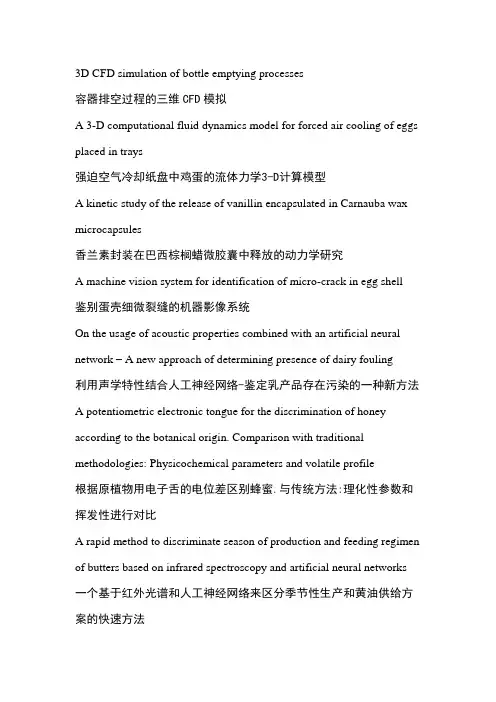
3D CFD simulation of bottle emptying processes容器排空过程的三维CFD模拟A 3-D computational fluid dynamics model for forced air cooling of eggs placed in trays强迫空气冷却纸盘中鸡蛋的流体力学3-D计算模型A kinetic study of the release of vanillin encapsulated in Carnauba wax microcapsules香兰素封装在巴西棕榈蜡微胶囊中释放的动力学研究A machine vision system for identification of micro-crack in egg shell鉴别蛋壳细微裂缝的机器影像系统On the usage of acoustic properties combined with an artificial neural network – A new approach of determining presence of dairy fouling利用声学特性结合人工神经网络-鉴定乳产品存在污染的一种新方法A potentiometric electronic tongue for the discrimination of honey according to the botanical origin. Comparison with traditional methodologies: Physicochemical parameters and volatile profile根据原植物用电子舌的电位差区别蜂蜜.与传统方法:理化性参数和挥发性进行对比A rapid method to discriminate season of production and feeding regimen of butters based on infrared spectroscopy and artificial neural networks 一个基于红外光谱和人工神经网络来区分季节性生产和黄油供给方案的快速方法A review: Crispness in dry foods and quality measurements based on acoustic–mechanical destructive techniques评审:基于声音仪器的破坏性试验对干燥食品酥脆度和质量的测量Aeration of model gels: Rheological characteristics of gellan and agar gels凝胶通气模式:结冷胶和琼脂凝胶的流变学特性Agglomeration of durum wheat semolina: Thermodynamic approaches for hydration properties measurements硬质小麦粗面粉的凝聚:热力学方法对于水合性能的测量Alleviating bottlenecks in a microbiology laboratory减少在微生物实验室中的瓶颈Effect of the amount of steam during baking on bread crust features and water diffusion面包在烘烤期间蒸汽对面包表皮特征和水扩散的影响An enzyme sensor for the determination of total amines in dry-fermented sausages一种酶传感器在腊肠风干发酵中对总有机胺的决定性An improved model of the seeded batch crystallization of glucose monohydrate from aqueous solutions从含水的溶解液中分批处理去籽的结晶化葡萄糖一水合物的一种改良模式An RFID application in the food supply chain: A case study of convenience stores in Taiwan无线射频识别在食品供应链中的应用:台湾便利储藏的案例研究Analytical model for variable moisture diffusivity estimation and drying simulation of shrinkable food products分析模型对可变湿度扩散性的估计和可收缩食品的干燥模拟Anthocyanin degradation kinetics during thermal and high pressure treatments of raspberries红草莓在高压和热处理下花青素退化的动力学Application of hybrid image features for fast and non-invasive classification of raisin图像特征混合对葡萄干快速和非侵入分类的应用Application of NIR hyperspectral imaging for discrimination of lamb muscles近红外高光谱对识别羔羊肌肉的应用Aqueous extraction of anthocyanins from Hibiscus sabdariffa: Experimental kinetics and modeling从洛神花中萃取花青素的实验历程和建模Aseptically packaged UHPH-treated apple juice: Safety and quality parameters during storage无菌包装超高压均质处理苹果汁:储藏中的安全与质量参数Automatic freshness assessment of cod (Gadus morhua) fillets by Vis/Nir spectroscopy利用可见近红外光谱对鳕鱼(大西洋鳕)鱼片新鲜度的自动评估Beer quality screening by FT-IR spectrometry: Impact of measurement strategies, data pre-processings and variable selection algorithms傅里叶变换红外光谱学光谱测定法对啤酒品质的筛选:测量方法,数据预处理和多变的算法选择对测量的影响Calcium effect on mechanical properties of model cell walls and apple tissue钙对典型细胞壁和苹果组织机械性能的作用CFD model development and validation of a thermonebulisation fungicide fogging system for postharvest storage of fruit热雾化杀菌剂系统对采收后食品储藏计算流体动力学模型的发展和确立Changes in orange juice characteristics due to homogenization and centrifugation橘子饮料特性因均化作用和离心分离所出现的变化Characterization and antimicrobial activity studies of polypropylene films with carvacrol and thymol for active packaging聚丙烯薄膜附加香芹酚和百里香酚对活性包装的表征和抗菌活性研究Characterization of bread dough: Rheological properties and microstructure面包面团的特性表述:流变性能和微观结构Coffee beans microstructural changes induced by cultivation processing: An X-ray microtomographic investigation种植加工引诱咖啡豆微观结构的变化:X射线微观层析成象的调查Combination of digital images and laser light to predict moisture content and color of bell pepper simultaneously during drying在干燥情况下,利用数字图像和激光灯的结合对灯笼椒的水分含量和颜色同时进行预测Comparative study of film forming behaviour of low and high amylose starches using glycerol and xylitol as plasticizers利用丙三醇和木糖醇作为增塑剂在高低直链淀粉质食品薄膜形成状况的对比性研究Comparison of total milk-clotting activity measurement precision using the Berridge clotting time method and a proposed optical method对比利用贝里奇凝固时间的方法和拟议光学方法对牛奶凝固活度的测量精度Compressive textural attributes, opacity and syneresis of gels prepared from gellan, agar and their mixtures压缩性组织的特性,从结冷胶,琼脂以及它们的混合物中凝胶准备的不透明度和脱水收缩作用Computer simulation model development and validation for radio frequency (RF) heating of dry food materials无线电频率对干燥食物材料加热的计算机模拟模型的发展和验证Crispiness of a microwave-expanded imitation cheese: Mechanical, acoustic and sensory evaluation微波扩大人造干酪的松脆物:力学,声学和感官评价Classification of black tea liquor using cyclic voltammetry利用循环伏安法对红茶白酒的分类Determination and removal of malondialdehyde and other2-thiobarbituric acid reactive substances in waste cooking oil检测和去除废弃食用油中丙二醛和其他2-硫代巴比土酸的反应物Determination of anthocyanin concentration in whole grape skins using hyperspectral imaging and adaptive boosting neural networks利用高光谱影像和适应促进神经网络测定全部葡萄皮中花青素浓度Determination of translucent content in mangosteen by meansof near infrared transmittance利用近红外透光率的方法对山竹果透明率的检测Development of a novel method to measure the film thickness of cured can coatings一个对腌罐头镀膜薄膜厚度测定新方法的发展Dielectric properties of sea cucumbers (Stichopus japonicus ) and model foods at 915 MHz典型食品和海参(刺参)在915MHz下的介电性能DMA peaks in potato cork tissue of different mealiness动态力学分析法在不同粉性的土豆软木组织的应用Influence of drying and hydrothermal treatment of corn on the denaturation of salt-soluble proteins and color parameters干燥和热处理玉米在可溶性盐蛋白和颜色参数变性上的影响Drying characteristics of mango slices using the Refractance Window™ technique芒果切片的干燥特性在折射窗薄层干燥技术上的应用Drying kinetics using superheated steam and quality attributes of dried pork slices for different thickness, seasoning and fibers distribution干燥动力学利用干燥猪肉切片的过热蒸汽和品质特性对不同厚度,风干和纤维分布的应用Dynamic oscillatory rheological measurement and thermal propertiesof pea protein extracted by salt method: Effect of pH and NaCl利用盐法对豌豆蛋白萃取的动态震荡流变测量和热性能:PH和盐的作用Dynamic oscillatory shear properties of O/W model system meat emulsions: Linear viscoelastic analysis for effect of temperature and oil concentration on protein network formation油水比率的动态振动剪切性能模型系统肉乳剂:线性粘弹性分析对温度和含油浓度在蛋白质网状形成的影响Effect of dimensions and geometry of co-field and co-linear pulsed electric field treatment chambers on electric field strength and energy utilization在电场强度和能量利用上共线性和共面性电场脉冲处理chambers的尺寸规模和几何体的影响Effect of high or low molecular weight of components of feed on transmembrane flux during forward osmosis促进渗透期间以跨膜通量为能源成分的分子量的高或低的影响Effect of morphology on water sorption in cellular solid foods. Part II: Sorption in cereal crackers水吸附在多细胞固体食品形态学的影响第二部分:吸附谷类饼干的吸附Effect of morphology on water sorption in cellular solid foods.Part I: Pore scale network model水吸附在多细胞固体食品形态学的影响第一部分:气孔比例网状模型Effect of salt and sucrose content on dielectric properties and microwave freeze drying behavior of re-structured potato slices盐和蔗糖含量对土豆切片复合组织介电性能和微博冷冻干燥的影响Effect of some operating variables on the microstructure and physical properties of a novel Kefir formulation一些运行变量对新克菲尔构想的微观结构和物理性能的影响Effects of electroplasmolysis treatment on chlorophyll and carotenoid extraction yield from spinach and tomato电质壁分离对菠菜和番茄中叶绿素和类胡萝卜素提取率的影响Effects of vacuum frying on structural changes of bananas真空油炸对香蕉结构变化的影响A finite element model for mechanical deformation of single tomato suspension cells一种对于单一番茄悬浮细胞的机械变形的有限元模式Enhanced survival of spray-dried microencapsulated Lactobacillus rhamnosus GG in the presence of glucose提高在葡萄糖前将装入乳酸菌鼠李糖GG的微胶囊进行喷雾干燥的残余物Enzymatic browning in sliced and puréed avocado: A fractal kinetic study 鳄梨和切片中的酶促褐变:一种分形动力学研究Enzyme inactivation kinetics and colour changes in Garlic (Allium sativum L.)blanched under different conditions在不同条件下大蒜变白中酶失活动力学和颜色的变化Evaluating banana ripening status from measuring dielectric properties利用介电性能测量香蕉成熟状况的评估Evaluating non-stick properties of different surface materials for contact frying不同表面材料的非粘性对接触油炸的评估Evaluation of Photoshop software potential for food colorimetry Photoshop软件对食品比色法可能性的评估Fast determination of boiling time of yardlong bean using visible and near infrared spectroscopy and chemometrics利用可见和近红外光谱学以及化学计量学快速测定长豇豆的沸腾时间Feasibility of NIR spectroscopy for non-destructive characterizationof table olive traits近红外光谱对表橄榄特性无损检测的可行性Food supply chain leanness using a developed QFD model食品供给链缺乏使用一种成熟的质量功能展开模式Fractal analysis of the retrogradation of rice starch by digital image processing利用数字图像处理米粉糊液凝沉的分形分析Frequency- and temperature-dependent dielectric properties of fruit juices associated with pasteurization by dielectric heating利用电介质加热杀菌法与果汁中与温度和频率有关的介电性能的相关性Development of a rapid, non-destructive method for egg contentdetermination in dry pasta using FT-NIR technique利用傅里叶变红外光谱技术测量鸡蛋内部的一种快速无损检测方法的发展Gelation properties of chicken myofibrillar protein induced by transglutaminase crosslinking利用转谷氨酰胺酶交联诱导鸡肉肌原纤维蛋白的胶凝特性Generalized microstructural change and structure-quality indicators of a food product undergoing different drying methods and conditions一种食品经过不同条件下和不同干燥方法的一般性微观结构变化和结构性能质量指标Glass transition phenomenon on shrinkage of papaya during convective drying木瓜在对流干燥期间玻璃转化现象的收缩Effect of saccharides on glass transition temperatures of frozen and freeze dried bovine plasma protein糖类在冷冻和冻结干燥牛血浆蛋白的玻璃转化温度的影响Heat transfer modelling in a refrigerated display cabinet: The influence of operating conditions冷藏展示柜的热传递模型:操作条件的影响Specific volume and compressibility measurements of tomato pasteat moderately high pressure as a function of temperature番茄酱在适当高压下作为温度函数比容和可压缩性测量Hybrid mixture theory based moisture transport and stress development in corn kernels during drying: Coupled fluid transport and stress equations基于在干燥期间玉米粒水分运输和压力发展的杂交混合理论:耦合流体运输和压力方程式Hydrodynamic, thermo-analytical and molecular structural investigations of enzyme interesterified oil and its thermo-oxidative stabilityby thermogravimetric analysis利用热重量分析对酯化油和其热氧化稳定的流体力学,热解析和分子结构的分析Classification of fresh Atlantic salmon (Salmo salar L.) fillets stored under different atmospheres by hyperspectral imaging利用高光谱影像对新鲜大西洋鲑鱼切片在不同气压下储藏的分类Imaged based estimation of food volume using circular referentsin dietary assessment饮食评估中食品体积的估计使用循环参照物的影像基础Quality classification of cooked, sliced turkey hams using NIR hyperspectral imaging system利用近红外高光谱影像系统对熟火鸡火腿切片的品质分级Implication of water activity and glass transition on the mechanicaland optical properties of freeze-dried apple and banana slices水活性和玻璃转化在冷冻干燥苹果和香蕉切片的力学光学性能的含义Inactivation of Saccharomyces cerevisiae in pineapple, grape and cranberry juices under pulsed and continuous thermo-sonication treatments酿酒酵母在菠萝,葡萄和蔓越橘汁脉冲和连续热声波降解法处理下的失活Investigating the performance of thermo nebulisation fungicide fogging system for loaded fruit storage room using CFD model利用流体力学模型计算热雾化杀菌剂雾化系统对已装水果储藏室性能的研究An Exploration of Why People Participate in Second Life Social Support Groups关于人们参加第二人生社会扶持组织原因的探索Kinetics of quality changes of pumpkin (Curcurbita maxima L.) stored under isothermal and non-isothermal frozen conditions南瓜储藏在等温和非等温冷冻条件下动力学性能的变化Kinetics studies during NaCl and KCl pork meat brining猪肉盐浸处理中氯化钠和氯化钾的动力学研究Linear and non-linear viscoelastic behaviors of crosslinked tapioca starch/polysaccharide systems交联木薯淀粉/多糖系统的线性和非线性粘弹性行为Monitoring changes in feta cheese during brining by magnetic resonanceimaging and NMR relaxometry在浸盐作用期间利用磁共振影像和核磁共振弛豫时间监测羊奶酪的变化Mathematical model of pork slice drying using superheated steam利用过热蒸汽干燥猪肉切片的数学模型Mathematical modeling of intermittent and convective drying of rice and coffee using the reaction engineering approach (REA)利用反作用工程方法间歇性和对流干燥大米,咖啡的数学建模Mathematical modeling of swelling in high moisture whey protein gels膨胀高水分乳清蛋白凝胶的数学建模Mathematical modeling of the heat and mass transfer in a stationary potato sphere impinged by a single round liquid jet in a hydro fluidization system利用单轮液体喷射在水电流态化系统在高温和质量传递在静止土豆表面撞击的数学建模An approach for the enhancement of the mechanical properties and film coating efficiency of shellac by the formation of composite films based on shellac and gelatin利用基于虫胶和明胶复合薄膜形成对虫胶的镀膜效率和机械性能提高的方法Mechanical relaxation times as indicators of stickiness in skimmilk–maltodextrin solids systems机械力松弛时间作为在粘性表层物牛奶麦芽糖糊精固体系统的指标Effect of composition on the mechanical response of agglomeratesof infant formulae初期公式的附聚物的机械回应成分的影响Combination of optical and non-destructive mechanical techniquesfor the measurement of maturity in peach光学和无损机械技术组合对桃子成熟的测量Expansion mechanism of extruded foams supplemented with wheat bran 增补挤压泡沫体伴随麦麸的膨胀原理Mechanistic model of in vitro salt release from model dairy gels based on standardized breakdown test simulating mastication乳品凝胶基于模拟粉碎稳定性试验标准在使观众盐释放的机械模型Mechanistic model to couple oxygen transfer with ascorbic acid oxidation kinetics in model solid food在固体食品模型中机械模型对结合氧运输随着抗坏血酸氧化的动力学Effect of sugar, citric acid and egg white type on the microstructuraland mechanical properties of meringues调和蛋白的糖,柠檬酸和蛋白类型在微观结构和机械性能的影响Microstructure and mechanical properties of soy protein/agar blend films: Effect of composition and processing methods大豆蛋白和琼脂膜混合的微观结构和机械性能:成分和处理方法的影响Coffea arabica beans microstructural changes induced by roasting: AnX-ray microtomographic investigation利用烘烤引诱咖啡豆微观结构的变化:一种X射线微层析调查The impact of microwave heating of infant formula model on neo-formed contaminant formation, nutrient degradation and spore destruction初级理论模型在新成立的污染物形成的微波加热的影响:营养退化和孢子退化Modeling and experimental validation of mass transfer from carbonated beverages in polyethylene terephthalate bottles从碳酸饮料在聚对苯二甲酸乙二醇酯瓶子中质量传递的实验验证和建模Modeling microbial kinetics as a function of temperature: Evaluationof dynamic experiments to identify the growth/inactivation interface根据温度对微生物动力学建模:动态实验的评估来鉴定增长/失活的分界面Modeling rehydration of porous food materials: I. Determinationof characteristic curve from water sorption isotherms多孔渗水食品材料的再水化建模:1,水等温吸附线中特性曲线的测定Modeling rehydration of porous food materials: II. The dual porosity approach多孔渗水食品材料的再水化建模:2,双重多孔性方法Modeling the effects of initial nitrogen content and temperatureon fermentation kinetics of hard cider初始含氮量和温度在苹果酒的发酵动力学的建模作用Modelling flow behaviour of dairy foams through a nozzle乳品泡沫通过喷嘴的建模流动状况Modelling of coupled heat and mass transfer during a contact baking process在联系烘烤进程期间耦合高温和质量传递的建模Monitoring and grading of tea by computer vision – A review利用计算机视觉对茶叶监测和分级-一个评审Monitoring of ATP and viable cells on meat surface by UV–Vis reflectance spectrum analysis利用紫外-可见反射比光谱分析对肉表面ATP和活细胞的监测Monitoring the dynamic density of dough during fermentation using digital imaging method利用数字影像方法在发酵期间对生面团的动态密度监测Microwave puffing: Determination of optimal conditions using a coupled multiphase porous media – Large deformation model微波膨化:利用一种耦合多相多孔介质对最适条件的测定-大型变形模型Red to far-red multispectral fluorescence image fusion for detection offecal contamination on apples利用红色对远红外多谱线的荧光影像融合对苹果排泄污染物的检测Artificial neural network model for prediction of cold spot temperature in retort sterilization of starch-based foods人工神经网络模型对淀粉性食物的蒸煮杀菌的冷点温度的预测Non-destructive analysis of anthocyanins in cherries by means of Lambert–Beer and multivariate regression based on spectroscopy and scatter correction using time-resolved analysis利用Lambert–Beer和多元回归基于光谱学和散射修正使用时间分辨分析对樱桃花青素的无损检测分析Non-destructive internal quality assessment of ‘‘Hayward’’ kiwifruitby waveguide spectroscopy利用波导光谱学对“Hayward”猕猴桃的内部品质无损检测Non-destructive maturity classification of mango based on physical, mechanical and optical properties基于物理,机械和光学特性对芒果成熟等级的无损检测Non-destructive prediction of hardening pericarp disorder in intact mangosteen by near infrared transmittance spectroscopy利用近红外线透射比光谱学对完整的山竹果无序表皮樱花的无损检测Efficacy of non-thermal technologies and sanitizer solutions on microbial load reduction and quality retention of strawberries非热能技术和食品防腐剂解决方案对草莓的微生物负荷减低和质量保持的功效Numerical modeling of heat and mass transfer during coffee roasting process咖啡豆烘烤进程的高温和质量传递数值模拟Accelerated inactivation of Geobacillus stearothermophilus spores by ohmic heating利用欧姆加热对芽孢杆菌的加速钝化Optimisation of total phenolic acids extraction from mandarin peels using microwave energy: The importance of the Maillard reaction利用微波能量从柑橘果皮对酚酸萃取的优化:美拉德反应的重要性Effect of guar gum content on some physical and nutritional properties of extruded products瓜尔豆胶在挤压产品的一些物理和营养特性的作用Physical properties of acerola and blueberry pulps金虎尾和蓝莓果肉的物理特性Physico-chemical characterization of chitosan-based edible films incorporating bioactive compounds of different molecular weight不同分子量的壳聚糖基可食用薄膜合并生物活性的化合物的理化特性Predicting cleaning time of ventilation duct systems in the food industry 通风管系统在食品工业的清洗时间预测Prediction of beef quality attributes using VIS/NIR hyperspectral scattering imaging technique利用可见/近红外高光谱散射影像技术队牛肉质量特性的预测Prediction of colloidal stability in white wines using infrared spectroscopy利用红外线光谱学对白葡萄酒胶体稳定性的预测Prediction of dry mass glass transition temperature and the spray drying behaviour of a concentrate using a desorption method利用解析方法对浓缩的干质量玻璃化温度和喷雾干燥状况的预测Production, recovery and applications of xanthan gum by Xanthomonas campestris利用白菜黄单胞菌对黄原胶的生产,恢复和应用Pulsed electric field assisted aqueous extraction of colorants from red beet电场脉冲协助红甜菜中色素的萃取Investigation of Raman chemical imaging for detection of lycopene changes in tomatoes during postharvest ripening利用拉曼化学成像在采收后成熟期间对番茄红素变化的检测的调查研究Real-time modeling of milk coagulation using in-line near infrared spectroscopy利用管线式近红外光谱学对牛奶凝结的即时性建模Removal of residual pesticide, fenitrothion, in vegetables by using ozone microbubbles generated by different methods用不同方法利用臭氧微气泡的产生对蔬菜杀虫剂(杀螟松)残渣的去除Effect of temperature on dynamic and steady-state shear rheological properties of siriguela (Spondias purpurea L.) pulp温度对松果菊果肉的动态和稳态切变流变学的影响Rheological behavior and stability of D-limonene emulsions made by a novel hydrocolloid (Angum gum) compared with Arabic gum由一种相比阿拉伯树胶的新水状胶体(Angum胶)制成的D-柠檬烯乳胶的流变特性和稳定性Modeling and estimation of rheological properties of food productsfor manufacturing simulations食品的流变特性对于制造模型的建模和评估Rheological, textural and spectral characteristics of sorbitol substituted mango jam山梨醇替代芒果果酱的流变的,组织的和光谱特性Rheology and microstructure of myofibrillar protein–plant lipid composite gels: Effect of emulsion droplet size and membrane type肌原纤维蛋白-植物油脂附和凝胶剂的流变学特性和微观结构:乳滴尺寸和薄膜类型的影响Rheometric non-isothermal gelatinization kinetics of mung bean starchslurry: Effect of salt and sugar – Part 1绿豆淀粉泥浆的流变测定非等温凝胶化动力学:盐和糖的作用-第一部分Scale-up unit of a unique moderately high pressure unit to enhance microbial inactivation唯一适度高压单元的增大单元来提高微生物失活Particle surface moisture content estimation using population balance modeling in fluidised bed agglomeration利用平衡建模的数量对使底座结块液化微粒表面水分含量的估测Shelf life prediction of aluminum foil laminated polyethylene packed vacuum dried coconut milk powder铝箔聚乙烯分层包装真空干燥椰子汁粉保质期的预测Effect of modified atmosphere and active packaging on the shelf-lifeof fresh bluefin tuna fillets改良环境和有效包装在新鲜金枪鱼切片保质期的影响Shortwave infrared hyperspectral imaging for detecting sour skin (Burkholderia cepacia)-infected onions短波红外线高光谱影像对被感染洋葱皮发酵的测定Wavelength selection in vis/NIR spectra for detection of bruises on apples by ROC analysis利用ROC分析用可见/近红外光谱对苹果损伤测定波长的选择Maltodextrin/pectin microparticles by spray drying as carrier fornutraceutical extracts喷雾干燥利用麦芽糖糊精/果胶微粒作为载体对保健品提取Structural properties of freeze-dried rice经过冷冻干燥大米的结构特性Study of contact angle, wettability and water vapor permeability in carboxymethylcellulose (CMC) based film with murta leaves(Ugni molinae Turcz) extract基于murta叶片薄膜萃取羧甲基纤维素接触角,湿润度和水蒸气渗透性的研究Granularity and its importance for traceability in a farmed salmon supply chain间隔尺寸以及其重要性对于养殖鲑鱼供给链的可追溯性Texture prediction during deep frying: A mechanistic approach油炸期间的质地预测:一种机械型工作设计方法The influence of vacuum impregnation on the fortification of apple parenchyma with quercetin derivatives in combination with pore structures X-ray analysis苹果软细胞组织附和橡黄素衍生物与X-射线孔隙结构分析结合的真空浸渍在营养强化上的影响The potential of electrospraying for hydrophobic film coating on foods 电喷镀对于在食品疏水性薄膜敷层的可能性The use of biodosimetry to measure the UV-C dose delivered to a sphere,and implications for the commercial treatment of fruit利用生物计量测定法测定紫外-C线剂量传递到球面,对于水果商业化处理的影响Corrigendum to ‘‘Theoretical and experimental analyses of drop deformation and break-up in a scale model of a high-pressure homogenizer’’ [Journal of Food Engineering 103/1 (2010) 21–28]勘误表:“高压均质器的液滴变形和终止缩尺模型的理论和实验分析”[食品工程杂志103/1(2010)21-28]Development of a two-band spectral imaging system for real-time citrus canker detection双频段光谱影像对于即时性检测柑橘溃疡的发展Shape determination of horticultural produce using two-dimensional computer vision – A review利用二维计算机影像对园艺产品形状的检测-一份评审Comparative study of high intensity ultrasound effects on foodproteins functionality高强度超声波作用在食物蛋白功能的对比性研究Uncertainty and sensitivity analysis: Mathematical model of coupled heat and mass transfer for a contact baking process不确定性和灵敏度分析:耦合高温和质量传递对于联系烘烤进程的数学模型Variable selection in visible and near-infrared spectra: Application toon-line determination of sugar content in pears可见和近红外光谱的可变性选择:应用于梨含糖量的即时检测Application of visible and near infrared spectroscopy for rapidand non-invasive quantification of common adulterants in Spirulina powder可见和近红外光谱对于螺旋藻粉共同掺杂物的快速以及非侵入性定量的应用Classification of longan fruit bruising using visible spectroscopy利用可见光谱学对桂圆损伤的分类Water diffusion and enzyme activities during malting of barley grains: A relationship assessment在大麦谷粒的麦粒发芽期间水扩散和酶活性:一个相关性评估Water transport properties of artificial cell walls人造细胞壁的水运输性能Weight loss of frozen bread dough under isothermal and fluctuating temperature storage conditions冷冻面包面团在等温和变动温度储藏条件下的质量损失Automated fish bone detection using X-ray imaging利用X-射线影像对鱼骨的自动化检测X-ray microtomography to study the microstructure of mayonnaiseX-射线显微断层显像对蛋黄酱微观结构的研究Influence of yeast and frozen storage on rheological, structural andmicrobial quality of frozen sweet dough酵母和冷冻储藏对冷冻甜面团的流变性,结构和微生物质量的影响Yield improvement in progressive freeze-concentration by partial melting of ice通过冷冻食品局部融化利用逐步冷冻浓缩提高产量。
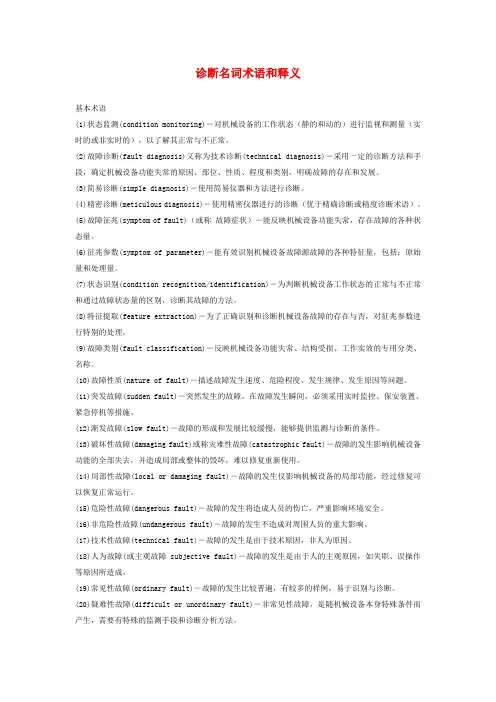
诊断名词术语和释义基本术语(1)状态监测(condition monitoring)-对机械设备的工作状态(静的和动的)进行监视和测量(实时的或非实时的),以了解其正常与不正常。
(2)故障诊断(fault diagnosis)又称为技术诊断(technical diagnosis)-采用一定的诊断方法和手段,确定机械设备功能失常的原因、部位、性质、程度和类别,明确故障的存在和发展。
(3)简易诊断(simple diagnosis)-使用简易仪器和方法进行诊断。
(4)精密诊断(meticulous diagnosis)-使用精密仪器进行的诊断(优于精确诊断或精度诊断术语)。
(5)故障征兆(symptom of fault)(或称故障症状)-能反映机械设备功能失常,存在故障的各种状态量。
(6)征兆参数(symptom of parameter)-能有效识别机械设备故障源故障的各种特征量,包括:原始量和处理量。
(7)状态识别(condition recognition/identification)-为判断机械设备工作状态的正常与不正常和通过故障状态量的区别,诊断其故障的方法。
(8)特征提取(feature extraction)-为了正确识别和诊断机械设备故障的存在与否,对征兆参数进行特别的处理。
(9)故障类别(fault classification)-反映机械设备功能失常、结构受损、工作实效的专用分类、名称。
(10)故障性质(nature of fault)-描述故障发生速度、危险程度、发生规律、发生原因等问题。
(11)突发故障(sudden fault)-突然发生的故障。
在故障发生瞬间,必须采用实时监控、保安装置、紧急停机等措施。
(12)渐发故障(slow fault)-故障的形成和发展比较缓慢,能够提供监测与诊断的条件。
(13)破坏性故障(damaging fault)或称灾难性故障(catastrophic fault)-故障的发生影响机械设备功能的全部失去,并造成局部或整体的毁坏,难以修复重新使用。
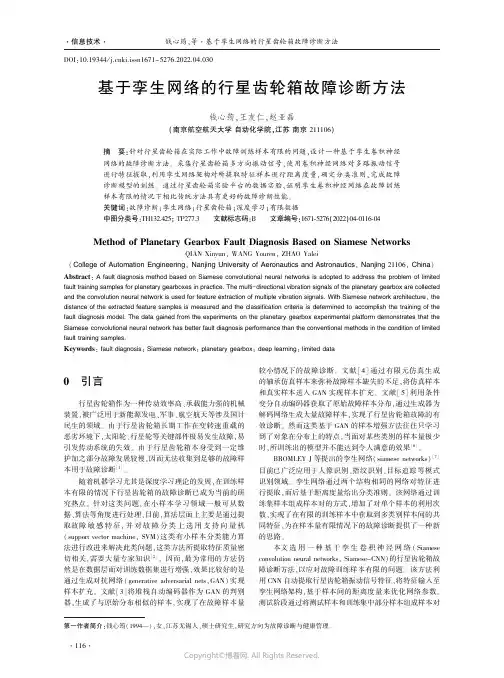
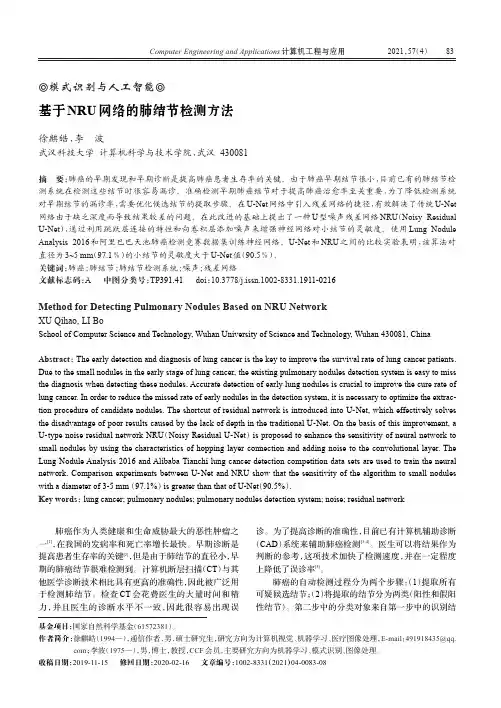
2021574肺癌作为人类健康和生命威胁最大的恶性肿瘤之一[1],在我国的发病率和死亡率增长最快。
早期诊断是提高患者生存率的关键[2],但是由于肺结节的直径小,早期的肺癌结节很难检测到。
计算机断层扫描(CT)与其他医学诊断技术相比具有更高的准确性,因此被广泛用于检测肺结节。
检查CT会花费医生的大量时间和精力,并且医生的诊断水平不一致,因此很容易出现误诊。
为了提高诊断的准确性,目前已有计算机辅助诊断(CAD)系统来辅助肺癌检测[3-4]。
医生可以将结果作为判断的参考,这项技术加快了检测速度,并在一定程度上降低了误诊率[5]。
肺癌的自动检测过程分为两个步骤:(1)提取所有可疑候选结节;(2)将提取的结节分为两类(阳性和假阳性结节)。
第二步中的分类对象来自第一步中的识别结基于NRU网络的肺结节检测方法徐麒皓,李波武汉科技大学计算机科学与技术学院,武汉430081摘要:肺癌的早期发现和早期诊断是提高肺癌患者生存率的关键。
由于肺癌早期结节很小,目前已有的肺结节检测系统在检测这些结节时很容易漏诊。
准确检测早期肺癌结节对于提高肺癌治愈率至关重要,为了降低检测系统对早期结节的漏诊率,需要优化候选结节的提取步骤。
在U-Net网络中引入残差网络的捷径,有效解决了传统U-Net 网络由于缺乏深度而导致结果较差的问题。
在此改进的基础上提出了一种U型噪声残差网络NRU(Noisy Residual U-Net),通过利用跳跃层连接的特性和向卷积层添加噪声来增强神经网络对小结节的灵敏度。
使用Lung Nodule Analysis2016和阿里巴巴天池肺癌检测竞赛数据集训练神经网络。
U-Net和NRU之间的比较实验表明,该算法对直径为3~5mm(97.1%)的小结节的灵敏度大于U-Net值(90.5%)。
关键词:肺癌;肺结节;肺结节检测系统;噪声;残差网络文献标志码:A中图分类号:TP391.41doi:10.3778/j.issn.1002-8331.1911-0216Method for Detecting Pulmonary Nodules Based on NRU NetworkXU Qihao,LI BoSchool of Computer Science and Technology,Wuhan University of Science and Technology,Wuhan430081,ChinaAbstract:The early detection and diagnosis of lung cancer is the key to improve the survival rate of lung cancer patients. Due to the small nodules in the early stage of lung cancer,the existing pulmonary nodules detection system is easy to miss the diagnosis when detecting these nodules.Accurate detection of early lung nodules is crucial to improve the cure rate of lung cancer.In order to reduce the missed rate of early nodules in the detection system,it is necessary to optimize the extrac-tion procedure of candidate nodules.The shortcut of residual network is introduced into U-Net,which effectively solves the disadvantage of poor results caused by the lack of depth in the traditional U-Net.On the basis of this improvement,a U-type noise residual network NRU(Noisy Residual U-Net)is proposed to enhance the sensitivity of neural network to small nodules by using the characteristics of hopping layer connection and adding noise to the convolutional layer.The Lung Nodule Analysis2016and Alibaba Tianchi lung cancer detection competition data sets are used to train the neural parison experiments between U-Net and NRU show that the sensitivity of the algorithm to small nodules with a diameter of3-5mm(97.1%)is greater than that of U-Net(90.5%).Key words:lung cancer;pulmonary nodules;pulmonary nodules detection system;noise;residual network⦾模式识别与人工智能⦾基金项目:国家自然科学基金(61572381)。
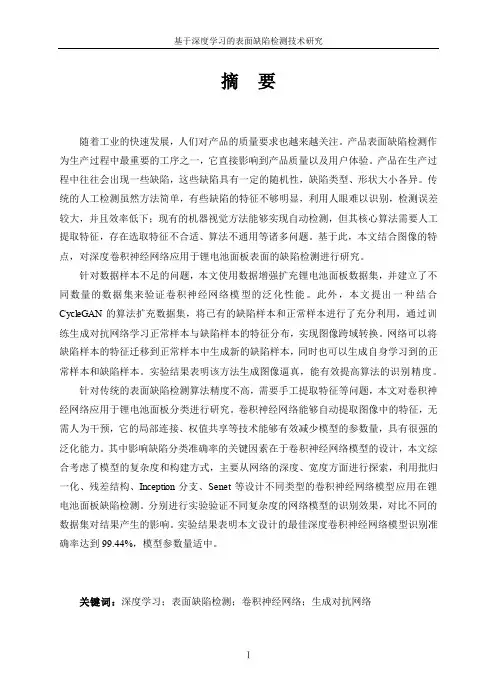
基于深度学习的表面缺陷检测技术研究摘要随着工业的快速发展,人们对产品的质量要求也越来越关注。
产品表面缺陷检测作为生产过程中最重要的工序之一,它直接影响到产品质量以及用户体验。
产品在生产过程中往往会出现一些缺陷,这些缺陷具有一定的随机性,缺陷类型、形状大小各异。
传统的人工检测虽然方法简单,有些缺陷的特征不够明显,利用人眼难以识别,检测误差较大,并且效率低下;现有的机器视觉方法能够实现自动检测,但其核心算法需要人工提取特征,存在选取特征不合适、算法不通用等诸多问题。
基于此,本文结合图像的特点,对深度卷积神经网络应用于锂电池面板表面的缺陷检测进行研究。
针对数据样本不足的问题,本文使用数据增强扩充锂电池面板数据集,并建立了不同数量的数据集来验证卷积神经网络模型的泛化性能。
此外,本文提出一种结合CycleGAN的算法扩充数据集,将已有的缺陷样本和正常样本进行了充分利用,通过训练生成对抗网络学习正常样本与缺陷样本的特征分布,实现图像跨域转换。
网络可以将缺陷样本的特征迁移到正常样本中生成新的缺陷样本,同时也可以生成自身学习到的正常样本和缺陷样本。
实验结果表明该方法生成图像逼真,能有效提高算法的识别精度。
针对传统的表面缺陷检测算法精度不高,需要手工提取特征等问题,本文对卷积神经网络应用于锂电池面板分类进行研究。
卷积神经网络能够自动提取图像中的特征,无需人为干预,它的局部连接、权值共享等技术能够有效减少模型的参数量,具有很强的泛化能力。
其中影响缺陷分类准确率的关键因素在于卷积神经网络模型的设计,本文综合考虑了模型的复杂度和构建方式,主要从网络的深度、宽度方面进行探索,利用批归一化、残差结构、Inception分支、Senet等设计不同类型的卷积神经网络模型应用在锂电池面板缺陷检测。
分别进行实验验证不同复杂度的网络模型的识别效果,对比不同的数据集对结果产生的影响。
实验结果表明本文设计的最佳深度卷积神经网络模型识别准确率达到99.44%,模型参数量适中。
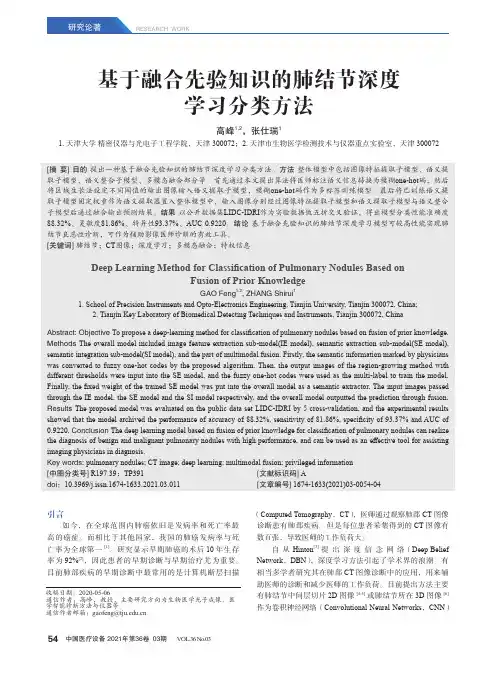
RESEARCH WORK引言如今,在全球范围内肺癌依旧是发病率和死亡率最高的癌症。
而相比于其他国家,我国的肺癌发病率与死亡率为全球第一[1]。
研究显示早期肺癌的术后10年生存率为92%[2],因此患者的早期诊断与早期治疗尤为重要。
目前肺部疾病的早期诊断中最常用的是计算机断层扫描(Computed Tomography,CT),医师通过观察肺部CT图像诊断患有肺部疾病。
但是每位患者采集得到的CT图像有数百张,导致医师的工作负荷大。
自从Hinton[3]提出深度信念网络(Deep Belief Network,DBN),深度学习方法引起了学术界的浪潮。
有相当多学者研究其在肺部CT图像诊断中的应用,用来辅助医师的诊断和减少医师的工作负荷。
目前提出方法主要有肺结节中间层切片2D图像[4-5]或肺结节所在3D图像[6]作为卷积神经网络(Convolutional Neural Networks,CNN)基于融合先验知识的肺结节深度学习分类方法高峰1,2,张仕瑞11. 天津大学精密仪器与光电子工程学院,天津 300072;2. 天津市生物医学检测技术与仪器重点实验室,天津 300072[摘 要] 目的提出一种基于融合先验知识的肺结节深度学习分类方法。
方法 整体模型中包括图像特征提取子模型、语义提取子模型、语义整合子模型、多模态融合部分等。
首先通过本文提出算法将医师标注语义信息转换为模糊one-hot码,然后将区域生长法设定不同阈值的输出图像输入语义提取子模型,模糊one-hot码作为多标签训练模型。
最后将已训练语义提取子模型固定权重作为语义提取器置入整体模型中,输入图像分别经过图像特征提取子模型和语义提取子模型与语义整合子模型后通过融合输出预测结果。
结果 以公开数据集LIDC-IDRI作为实验数据做五折交叉验证,得出模型分类性能准确度88.32%、灵敏度81.86%、特异性93.37%、AUC 0.9220。
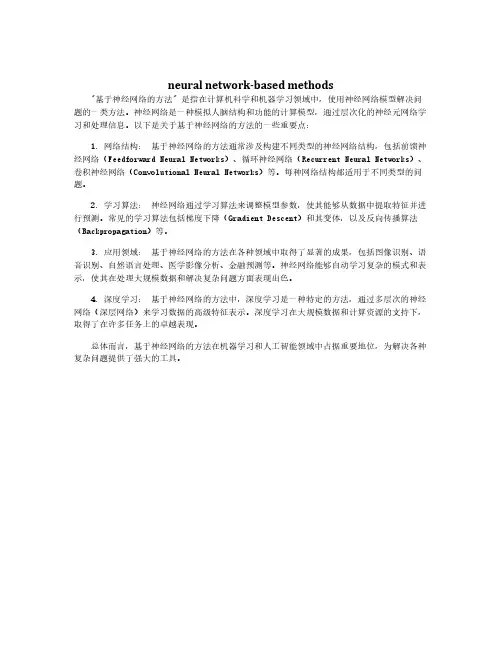
neural network-based methods
"基于神经网络的方法"是指在计算机科学和机器学习领域中,使用神经网络模型解决问题的一类方法。
神经网络是一种模拟人脑结构和功能的计算模型,通过层次化的神经元网络学习和处理信息。
以下是关于基于神经网络的方法的一些重要点:
1.网络结构:基于神经网络的方法通常涉及构建不同类型的神经网络结构,包括前馈神经网络(Feedforward Neural Networks)、循环神经网络(Recurrent Neural Networks)、卷积神经网络(Convolutional Neural Networks)等。
每种网络结构都适用于不同类型的问题。
2.学习算法:神经网络通过学习算法来调整模型参数,使其能够从数据中提取特征并进行预测。
常见的学习算法包括梯度下降(Gradient Descent)和其变体,以及反向传播算法(Backpropagation)等。
3.应用领域:基于神经网络的方法在各种领域中取得了显著的成果,包括图像识别、语音识别、自然语言处理、医学影像分析、金融预测等。
神经网络能够自动学习复杂的模式和表示,使其在处理大规模数据和解决复杂问题方面表现出色。
4.深度学习:基于神经网络的方法中,深度学习是一种特定的方法,通过多层次的神经网络(深层网络)来学习数据的高级特征表示。
深度学习在大规模数据和计算资源的支持下,取得了在许多任务上的卓越表现。
总体而言,基于神经网络的方法在机器学习和人工智能领域中占据重要地位,为解决各种复杂问题提供了强大的工具。
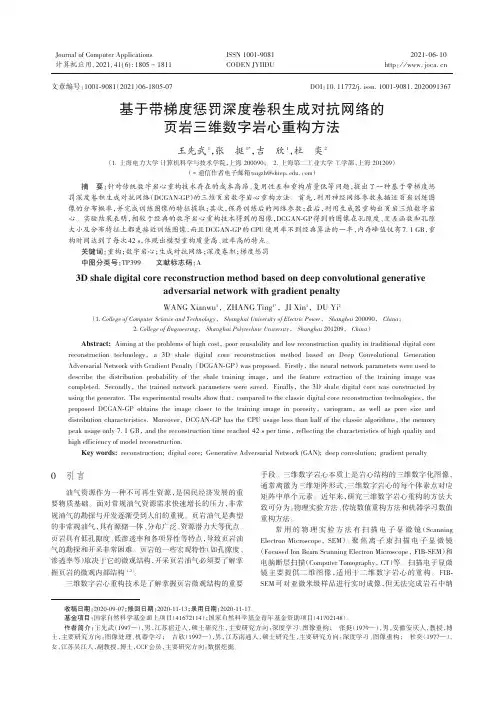
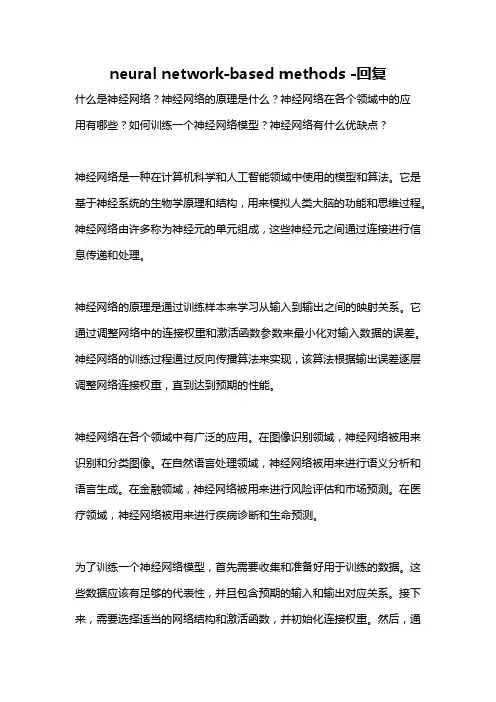
neural network-based methods -回复什么是神经网络?神经网络的原理是什么?神经网络在各个领域中的应用有哪些?如何训练一个神经网络模型?神经网络有什么优缺点?神经网络是一种在计算机科学和人工智能领域中使用的模型和算法。
它是基于神经系统的生物学原理和结构,用来模拟人类大脑的功能和思维过程。
神经网络由许多称为神经元的单元组成,这些神经元之间通过连接进行信息传递和处理。
神经网络的原理是通过训练样本来学习从输入到输出之间的映射关系。
它通过调整网络中的连接权重和激活函数参数来最小化对输入数据的误差。
神经网络的训练过程通过反向传播算法来实现,该算法根据输出误差逐层调整网络连接权重,直到达到预期的性能。
神经网络在各个领域中有广泛的应用。
在图像识别领域,神经网络被用来识别和分类图像。
在自然语言处理领域,神经网络被用来进行语义分析和语言生成。
在金融领域,神经网络被用来进行风险评估和市场预测。
在医疗领域,神经网络被用来进行疾病诊断和生命预测。
为了训练一个神经网络模型,首先需要收集和准备好用于训练的数据。
这些数据应该有足够的代表性,并且包含预期的输入和输出对应关系。
接下来,需要选择适当的网络结构和激活函数,并初始化连接权重。
然后,通过将输入数据传递给网络并计算输出,来评估模型的性能。
之后,使用误差函数来度量模型的预测误差,并通过反向传播算法来调整连接权重。
这个过程会重复多次,直到模型达到预期的性能。
神经网络的优点之一是它可以学习从大量数据中提取特征和模式。
它可以自动调整模型参数,以适应不同的数据和任务。
此外,神经网络可以进行非线性建模,可以处理复杂的输入和输出关系。
神经网络还具有良好的泛化能力,可以在不可见的数据上做出具有较高准确性的预测。
然而,神经网络也有一些缺点。
首先,它需要大量的训练数据和计算资源来提取有效的模型。
其次,神经网络的结构和参数选择可能需要进行多次尝试和优化。
此外,神经网络的执行速度较慢,特别是在大规模数据和复杂模型的情况下。
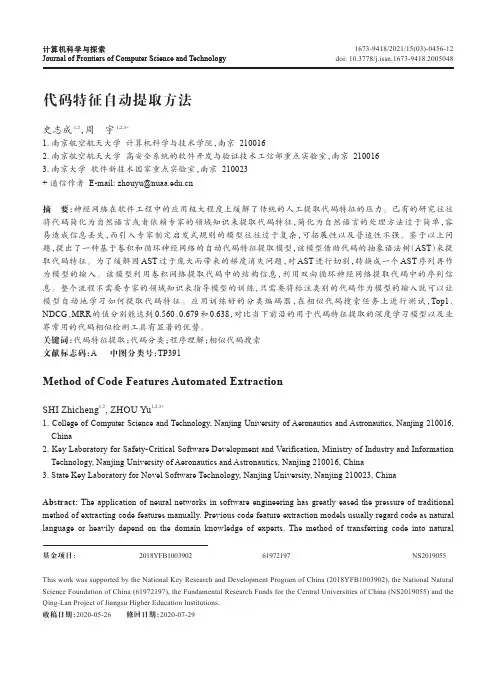
代码特征自动提取方法史志成1,2,周宇1,2,3+1.南京航空航天大学计算机科学与技术学院,南京2100162.南京航空航天大学高安全系统的软件开发与验证技术工信部重点实验室,南京2100163.南京大学软件新技术国家重点实验室,南京210023+通信作者E-mail:***************.cn 摘要:神经网络在软件工程中的应用极大程度上缓解了传统的人工提取代码特征的压力。
已有的研究往往将代码简化为自然语言或者依赖专家的领域知识来提取代码特征,简化为自然语言的处理方法过于简单,容易造成信息丢失,而引入专家制定启发式规则的模型往往过于复杂,可拓展性以及普适性不强。
鉴于以上问题,提出了一种基于卷积和循环神经网络的自动代码特征提取模型,该模型借助代码的抽象语法树(AST )来提取代码特征。
为了缓解因AST 过于庞大而带来的梯度消失问题,对AST 进行切割,转换成一个AST 序列再作为模型的输入。
该模型利用卷积网络提取代码中的结构信息,利用双向循环神经网络提取代码中的序列信息。
整个流程不需要专家的领域知识来指导模型的训练,只需要将标注类别的代码作为模型的输入就可以让模型自动地学习如何提取代码特征。
应用训练好的分类编码器,在相似代码搜索任务上进行测试,Top1、NDCG 、MRR 的值分别能达到0.560、0.679和0.638,对比当下前沿的用于代码特征提取的深度学习模型以及业界常用的代码相似检测工具有显著的优势。
关键词:代码特征提取;代码分类;程序理解;相似代码搜索文献标志码:A中图分类号:TP391Method of Code Features Automated ExtractionSHI Zhicheng 1,2,ZHOU Yu 1,2,3+1.College of Computer Science and Technology,Nanjing University of Aeronautics and Astronautics,Nanjing 210016,China2.Key Laboratory for Safety-Critical Software Development and Verification,Ministry of Industry and Information Technology,Nanjing University of Aeronautics and Astronautics,Nanjing 210016,China3.State Key Laboratory for Novel Software Technology,Nanjing University,Nanjing 210023,ChinaAbstract:The application of neural networks in software engineering has greatly eased the pressure of traditional method of extracting code features manually.Previous code feature extraction models usually regard code as natural language or heavily depend on the domain knowledge of experts.The method of transferring code into natural计算机科学与探索1673-9418/2021/15(03)-0456-12doi:10.3778/j.issn.1673-9418.2005048基金项目:国家重点研发计划(2018YFB1003902);国家自然科学基金(61972197);中央高校基本科研业务费专项资金(NS2019055);江苏高校“青蓝工程”。
doi:10.3969/j.issn.1003-3114.2022.04.017引用格式:张茜茜ꎬ王禹ꎬ林云ꎬ等.基于深度学习的自动调制识别方法综述[J].无线电通信技术ꎬ2022ꎬ48(4):697-710.[ZHANGXixiꎬWANGYuꎬLINYunꎬetal.AComprehensiveSurveyofDeepLearning ̄basedAutomaticModulationRecognitionMethods[J].RadioCommunicationsTechnologyꎬ2022ꎬ48(4):697-710.]基于深度学习的自动调制识别方法综述张茜茜1ꎬ王㊀禹1ꎬ林㊀云2ꎬ桂㊀冠1∗(1.南京邮电大学通信与信息工程学院ꎬ江苏南京210003ꎻ2.哈尔滨工程大学信息与通信工程学院ꎬ黑龙江哈尔滨150001)摘㊀要:自动调制识别(AutomaticModulationRecognitionꎬAMR)是复杂电磁环境下的信号感知和识别领域中的重要技术ꎬ广泛应用于频谱感知㊁链路自适应㊁干扰防护等领域ꎮ传统的AMR方法主要依赖于人工提取特征㊁决策理论和识别器的选择ꎮ而深度学习(DeepLearningꎬDL)算法直接从海量数据中自动获取信号特征ꎬ同时实现特征提取和识别ꎮ因此ꎬ针对复杂多变的电磁环境中的信号识别问题ꎬ提出了将DL算法应用于AMR任务ꎮ首先ꎬ从数据集㊁信号表示和网络模型三个层面系统地综述基于DL的AMR方法ꎻ其次ꎬ详细总结了针对不同的信号表示所设计的神经网络模型ꎬ其中接收信号可以由专家特征㊁序列和图像来表示ꎻ最后概述了AMR存在的问题㊁潜在的研究方向和结论ꎮ关键词:自动调制识别ꎻ信号感知ꎻ深度学习中图分类号:TN919㊀㊀㊀文献标志码:A㊀㊀㊀开放科学(资源服务)标识码(OSID):文章编号:1003-3114(2022)04-0697-14AComprehensiveSurveyofDeepLearning ̄basedAutomaticModulationRecognitionMethodsZHANGXixi1ꎬWANGYu1ꎬLINYun2ꎬGUIGuan1∗(1.CollegeofTelecommunicationsandInformationEngineeringꎬNanjingUniversityofPostsandTelecommunicationsꎬNanjing210003ꎬChinaꎻ2.CollegeofInformationandCommunicationEngineeringꎬHarbinEngineeringUniversityꎬHarbin150001ꎬChina)Abstract:Automaticmodulationrecognition(AMR)isanimportanttechnologyforsignalsensingandrecognitionincomplexelec ̄tromagneticenvironment.Itiswidelyusedincivilandmilitaryfieldsincludingspectrumsensingꎬlinkadaptationꎬinterferenceprotectionandsoon.TraditionalAMRmethodsmainlyrelyonmanualfeatureextractionꎬdecisiontheoryandselectionofrecognizer.Deeplearning(DL)algorithmautomaticallyobtainssignalfeaturesdirectlyfrommassivedataꎬandrealizesfeatureextractionandrecognitionatthesametime.ThereforeꎬaimingattheproblemofsignalrecognitionincomplexandchangeableelectromagneticenvironmentꎬDLalgorithmisappliedtoAMRtask.FirstlyꎬanAMRmethodbasedonDLissystematicallysummarizedfromthreeaspects:datasetꎬsignalrepresen ̄tationandnetworkmodel.Secondlyꎬneuralnetworkmodelsdesignedfordifferentsignalrepresentationsaresummarizedindetailꎬinwhichthereceivedsignalscanberepresentedbyexpertfeaturesꎬsequencesandimages.Finallyꎬexistingproblemsꎬpotentialresearchdi ̄rectionsandconclusionsofAMRaresummarized.Keywords:automaticmodulationrecognition(AMR)ꎻsignalsensingꎻdeeplearning(DL)收稿日期:2022-03-22基金项目:科技创新2030 新一代人工智能 重大项目(2021ZD0113003)FoundationItem:SupportedbyScienceandTechnologyInnovation2030MajorProgram:NewGenerationArtificialIntelligence(2021ZD0113003)0 引言自动调制识别(AutomaticModulationRecognitionꎬAMR)是信号检测和解调之间的重要步骤ꎬ它的目的是在不了解信号先验调制信息的情况下ꎬ通过信号处理技术识别出接收信号的调制类型ꎬ其在许多无线通信场景中均发挥着重要的作用[1]ꎮ在军事领域中ꎬAMR广泛用于信号监测㊁干扰识别和电子对抗等方面[1-4]ꎻ在民用领域中ꎬAMR广泛应用于无线电管理㊁频谱感知和软件无线电等场景中[5-6]ꎬ因此AMR技术被国内学者广泛关注并且深入研究ꎮ传统的AMR主要分为基于似然函数的方法[7-8]和基于特征提取的方法[9-10]ꎮ基于似然函数的识别方法理论上确保了识别结果在贝叶斯最小误判代价准则下是最优的ꎬ然而该方法计算复杂度高且对模型失配和参数偏差比较敏感ꎬ在实际的复杂电磁环境中很难实现[11-12]ꎮ而基于特征提取的方法由经典模式识别理论衍生而来ꎬ其本质可视为一种映射关系ꎬ即从信号空间映射到特征空间ꎮ具体来说:一方面ꎬ把高维的接收信号空间映射到维数尽可能小的特征空间ꎬ以降低复杂度ꎻ另一方面ꎬ提取的特征应尽可能地显示出不同调制类型之间的差异ꎬ以取得更好的识别性能ꎮ虽然基于特征提取的方法不是最优的ꎬ但如果能提取到足够多的有效特征ꎬ性能也会接近最优且容易实现ꎮ近年来ꎬ人工智能(ArtificialIntelligenceꎬAI)的发展日益成熟ꎬ其中机器学习(MachineLearningꎬML)和深度学习(DeepLearningꎬDL)成为AI研究的主流ꎬ并在图像识别[13]㊁语音识别[14]和自动驾驶[15]等应用领域呈现出压倒性的优势ꎮ通常ꎬ基于ML的AMR方法ꎬ如决策树(DecisionTreeꎬDT)[16]㊁K最邻近(K ̄NearestNeighborꎬKNN)[17-18]㊁支持向量机(SupportVectorMachineꎬSVM)[19-21]等采用模型驱动的方法ꎬ该方法所提取的特征需要一定的专业知识与经验ꎬ并且还需要得知调制池的先验信息ꎮ一旦假设的信号模型或噪声模型与实际的信号或噪声不匹配ꎬ就会发生误判别ꎮ而基于DL的AMR方法采用数据驱动的方法[22]ꎬ该方法所使用的网络比以前的神经网络深得多ꎬ它在无需人工干预的情况下从原始数据中自动提取复杂的特征并做出有效的识别决策ꎬ即通过端到端的方式提取和识别信号特征ꎮ最近一些研究表明ꎬDL方法可以克服ML的一些障碍并在AMR领域中实现最先进的性能ꎬ因为它具有从不同调制格式中学习辨别特征的优异能力[23]ꎮ此外ꎬDL方法已普遍应用于各种通信技术中ꎬ如波束形成[24]㊁非正交多址接入[25-26]和信道估计[27]等ꎮ基于DL的AMR方法具有强大的特征提取能力和分类回归能力ꎬ能够有效地对调制信号进行预测和识别ꎮDL方法在大数据驱动下ꎬ依靠自主学习分析数据规律ꎮ概括出更多层面更有代表性的数据特征ꎬ从而脱离了对特征工程的依赖ꎬ在图像㊁语音等任务上取得了超过其他算法的效果ꎮ基于DL的AMR方法主要包括卷积神经网络(ConvolutionalNeuralNetworkꎬCNN)㊁循环神经网路(RecurrentNeuralNetworkꎬRNN)和自动架构搜索(AutomaticArchitec ̄tureSearchꎬNAS)等方法ꎮCNN作为一种重要的具有深层结构且包含卷积计算的前馈神经网络ꎬ其通过权值共享和稀疏连接来降低模型的复杂度ꎬ并从接收信号中自动提取特征信息ꎬ发现接收样本中的特征规律ꎬ从而实现调制信号的有效识别[28]ꎮRNN有一个内存来存储它已经从之前的输入数据中学到的输出ꎬ它可以处理一段时间内的向量序列[29]ꎮ但是RNN存在短期记忆问题ꎬ而长短时记忆(LongandShortTermMemoryꎬLSTM)作为RNN的一种优化算法可以保留较长序列数据中的重要信息ꎬ忽略不重要的信息ꎬ从而解决RNN短期记忆的问题ꎮNAS可以认为是一种任务驱动的方法ꎬ该方法可以根据样本集自动设计出优异的深度神经网络(DeepNeuralNetworkꎬDNN)模型ꎬ而无需大量的专业知识和反复的试验ꎬ降低成本的同时ꎬ甚至会发现人类专家之前未曾提出的网络结构[30]ꎮ本文将近年来提出的AMR方法按照经过预处理后的信号表示方式分为三类:第一类是直接从接收到的信号中提取专家经验特征ꎬ然后再利用神经网络进行识别ꎮHassank等人[31]将连续小波变换的高阶统计矩作为特征集ꎬ输入到多层前馈神经网络进行识别ꎬ并利用主成分分析(PrincipalComponentAnalysisꎬPCA)降低网络复杂度ꎬ以提高识别器的性能ꎮLi等人[32]提出了一种基于抗噪声处理和深度稀疏滤波CNN模型的甚高频信号调制识别方法ꎬ首先提取采样信号的循环谱并用低秩表示ꎬ然后采用稀疏滤波对CNN进行训练ꎬ以高模型的泛化能力ꎮ第二类是直接将同相正交(In ̄PhaseQuadratureꎬIQ)信号作为神经网络输入数据ꎮWang等人[22]设计的CNN模型可以在时变信噪比(SignaltoNoiseRatioꎬSNR)条件下学习IQ样本的特征ꎬ该CNN模型具有更强大的识别能力ꎬ且在实际应用中具有更高的鲁棒性ꎮLiu等人[33]提出了一种双向卷积选通递归深度网络架构ꎬ其将CNN㊁门控循环单元(GatedCirculationUnitꎬGRU)和DNN三种网络各自的优点结合起来ꎬ从而实现高精度的调制识别ꎮ文献[34]提出了一种用于AMR的经济且高效的CNNꎬ其输入为IQ分量ꎮ第三类是将采样得到的IQ信号转换为图像的形式ꎬ如星座图㊁时频图和循环谱图等ꎬ这样就将信号识别问题转换为图像识别问题ꎬ然后利用计算机视觉(ComputerVisionꎬCV)领域中的DL算法对其进行识别ꎮ为了在困难的调制类型上获得更高的精度ꎬ文献[35]设计了基于星座图的模型ꎬ实验结果表明ꎬ即使在低SNR的情况下ꎬ该模型也能有效地识别出16QAM和64QAMꎮ文献[36]将接收信号转换为时频图像ꎬ并采用多模融合模型对手工特征与图像特征进行融合ꎬ其采用ResNet作为特征提取器ꎮ文献[37]提出一种基于CNN二维循环谱图的AMR方法ꎬ仿真结果表明ꎬ该系统能有效地识别出RadioML2016.10a数据集中的11种调制信号ꎬ且在较高的识别精度下ꎬ只占用较低的内存和计算开销ꎮ1㊀系统模型和问题描述AMR系统模型如图1所示ꎮ在发射端ꎬ输入信息i(t)经过调制得到调制信号s(t)ꎮs(t)在传输过程中会受到信道衰落和噪声干扰的影响ꎮ在接收端ꎬ接收信号x(t)表示为:x(t)=s(t)∗h(t)+n(t)ꎬ其中ꎬh(t)代表多径信道ꎬn(t)代表加性噪声ꎮ基于DL的AMR方法可以同时实现特征提取和识别ꎬ从而摆脱复杂且困难的人工特征设计部分ꎮ具体而言ꎬ基于DL的AMR通常分为两个阶段:在第一个阶段中ꎬ对接收到的信号进行预处理ꎬ预处理是指对采集到的信号进行分析和处理ꎬ以获得良好的信号表示(如振幅㊁相位㊁星座图或更复杂的特征)ꎻ在第二个阶段中ꎬ利用CNN㊁RNN和NAS等DL算法来自动提取信号特征并预测信号的调制类型ꎮ前一个阶段比较耗时ꎬ但可以事先离线执行ꎮ而第二个阶段花费时间少ꎬ但需要在线执行ꎬ这有助于在复杂多变的电磁环境中进行实时的AMRꎮ如图2所示ꎬ本文分别综述数据集㊁信号的表示方式和基于DL的算法ꎮ图1㊀基于DL的AMR系统模型Fig.1㊀DLbasedAMRsystemmodel图2㊀基于DL的AMR方法总体组织结构图Fig.2㊀OverallorganizationchartofDLAMRbasedmethod1.1㊀数据集在数据驱动的DL模型中ꎬ训练㊁验证和测试神经网络都需要海量的信号数据ꎮ一些研究人员使用Matlab模拟的数据集[38-39]ꎬ而另一些研究人员更喜欢使用一些开源数据集[40-42]ꎮ文献[40]提出了一项关于ML在无线电信号处理领域新兴应用的调查ꎬ并合成了RadioML2016.10A数据集ꎮ该数据集基于GNURadio环境生成ꎬ包含11种调制信号ꎬ每种调制信号包括20种SNRꎬ每种SNR有1000个样本ꎬ每个样本有I和Q两路信号ꎬ每路信号包含128个采样点ꎮ此外ꎬ这个数据集有一个更大的版本ꎬ叫做RadioML2016.10B[41]ꎮ文献[42]介绍了一个更具挑战性的调制识别数据集RadioML2018.10Aꎬ它包含24种调制方案ꎬ每种调制信号包括26种SNRꎬ每种SNR有4096个样本ꎬ每个样本有I和Q两路信号ꎬ每路信号包含1024个采样点ꎮ表1总结了关于数据集的调制方案㊁SNR范围㊁样本总量以及影响因素ꎮZhang等人[38]提出了一种适用于5GNR系统的通用信道数据集生成器ꎬ该数据集生成器可以根据用户的需求设置不同的信道参数ꎬ也可以生成大量的多输入多输出(MultipleInputMultipleOutputꎬMIMO)信道ꎮWest等人[39]介绍了一种用于训练神经网络的新数据集ꎬ以执行宽带信号识别ꎮ表1㊀数据集总结Tab.1㊀Summaryofdataset数据集调制池SNR范围/dB样本总量ˑ104影响因素RadioML2016.10A[40]11种:8PSKꎬBPSKꎬCPFSKꎬGFSKꎬPAM4ꎬ16QAMꎬ64QAMꎬQPSKꎬAM ̄SSBꎬAM ̄DSBꎬWBFM[-20ꎬ18]22载波频率偏移(CFO)㊁采样率偏移㊁AWGN㊁多径衰落RadioML2016.10B[41]10种:8PSKꎬBPSKꎬCPFSKꎬGFSKꎬPAM4ꎬ16QAMꎬ64QAMꎬQPSKꎬAM ̄DSBꎬWBFM[-20ꎬ18]20CFO㊁采样率偏移㊁AWGN㊁多径衰落RadioML2018.10A[42]24种:OOKꎬ4ASKꎬ8ASKꎬBPSKꎬQPSKꎬ8PSKꎬ16PSKꎬ32PSKꎬ16APSKꎬ32APSKꎬ64APSKꎬ128APSKꎬ16QAMꎬ32QAMꎬ64QAMꎬ128QAMꎬ256QAMꎬAM ̄SSB ̄WCꎬAM ̄SSB ̄SCꎬAM ̄DSB ̄WCꎬAM ̄DSB ̄SCꎬFMꎬGMSKꎬOQPSK[-20ꎬ30]255.5904CFO㊁符号率偏移㊁热噪声㊁多径衰落1.2㊀信号表示方式在基于DL的调制识别中ꎬ将接收到的信号输入神经网络之前ꎬ需要对信号进行预处理ꎬ从而以恰当的形式作为神经网络的输入数据ꎮ现有的基于DL的调制识别算法的信号表示主要分为专家特征表示㊁序列表示和图像表示三大类ꎬ表2对这三类信号表示及其特点进行了概述ꎮ表2㊀信号表示方式及特点概述Tab.2㊀Overviewofsignalrepresentationandcharacteristics信号表示特点专家经验表示瞬时特征[43ꎬ46-47]高阶统计特征[43-44ꎬ46]频谱特征[45ꎬ48]提取多个特征来表示接收到的信号ꎮ能够取得较好的效果ꎬ但依赖于专家设计和信号条件ꎮ序列表示IQ序列[49-53]AP序列[54-58]是一种直观的信号表示方式ꎬ倍受研究人员的欢迎ꎮ图像表示时频图[59-63]星座图[64-67]循环谱图[37]受到DL在计算机视觉领域取得了杰出成就的启发ꎬ将接收到的信号转换成图像形式ꎬ通过图像识别完成调制识别ꎮ1.2.1㊀专家经验表示在特定条件下专家经验特征(包括瞬时参数统计特征㊁高阶统计量特征和频谱特征等)能够取得较好的识别效果ꎬ但该特征依赖于专家设计和信号条件ꎮ文献[43]将瞬时特征和高阶统计特征等手动提取的特征与CNN提取的上下文特征串联ꎬ以解决11种不同类型的调制识别任务ꎮ文献[44]中特征提取结构由两个组件构成:第一部分从接收信号中提取四阶累积量ꎬ第二部分从接收到的IQ信号中提取极坐标ꎮ此外ꎬ作者在低SNR条件下ꎬ通过使用深度信念网络平台和尖峰神经网络平台ꎬ克服与DL体系结构相关的执行延迟问题ꎬ有助于提高分类精度ꎮ文献[45]对于每种调制方案ꎬ针对不同的SNR值提取不同的频谱特征(如最大频谱功率密度㊁瞬时相位标准差㊁直接瞬时值的标准偏差等)ꎮ基于所提取的有效特征ꎬ训练神经网络以识别不同的调制类型ꎮKim等人[46]提出了DNN的模型ꎬ且从基带信号中提取的21种不同特征来识别具有低浅层结构的BPSK㊁QPSK㊁8PSK㊁16QAM和64QAM信号ꎮ文献[47]讨论了从接收到的复杂信号中提取的5种特征ꎬ这些特征是通过在不同调制方案下改变SNR获得的ꎬ作者采用了前馈神经网络和概率神经网络进行调制识别ꎮYao等人[48]使用小波变换峰值搜索对16QAM和64QAM进行识别ꎬ仿真结果表明ꎬ在SNR为10dB时ꎬ平均识别率提高了11.5%ꎮ1.2.2㊀序列表示接收信号通常可以用IQ序列和振幅相位(AmplitudePhaseꎬAP)序列来表示ꎮ文献[40]首次提出利用IQ序列进行基于DL的调制识别ꎬ其识别了11种调制信号(包括8种数字调制类型和三种模拟调制类型)ꎮ随后ꎬ许多研究人员选择使用现有的IQ信号数据集作为CNN的输入ꎮ文献[49]使用纯IQ数据进行模拟实验ꎬ论证了CNN㊁残差网络(ResNet)等网络结构在调制识别任务中的性能ꎬ首次提出识别精度不受网络深度的限制ꎮ文献[50]使用由两个卷积层和三个全连接层组成的CNN来处理正交频分多址(OrthogonalFrequencyDivisionMultipleAccessꎬOFDMA)系统中的IQ序列ꎬ以实现对接收信号高鲁棒的AMRꎮ此外ꎬ文献[51]消除了OFDM系统中载波相位的有害影响ꎬ以进一步提高识别的精度ꎮ在文献[52]中ꎬ超长IQ序列被划分为多个子序列ꎬ以适应不同的序列长度ꎬ并运用迁移学习来提高再训练效率ꎮ文献[53]研究了在MIMO系统中ꎬ使用多个天线接收的IQ序列的协作调制识别ꎬ与传统的专家设计特征方法相比ꎬ基于CNN的协同AMR方法具有更好的性能ꎮChen等人[54]通过提取AP信息和数据增强操作ꎬ使得DL模型具有更强的泛化能力和更高的鲁棒性ꎮRajendran等人[55]提出ꎬ通过将IQ数据转换为AP信息并使用LSTM模型ꎬ以实现良好的识别准确率ꎬ该模型能够自动从训练数据中获得信号的时间特征ꎬ而无需人工提取专家特征ꎮZhang等人[56]提出了基于CNN ̄LSTM的AMR双流结构ꎬ一个流从原始的IQ信号中提取局部原始时间特征ꎬ另一个流从AP信息中学习空间知识ꎮ从两个流中训练的特征成对交互ꎬ丰富了特征的多样性ꎬ进一步提高了模型的性能ꎮZhang等人[57]提出一种预处理方法ꎬ即通过将输入数据从IQ序列转换为AP序列ꎬ并针对此AP序列设计了一个带有残余块的CNNꎬ从而形成了一个具有高识别精度的AMR系统ꎮ文献[40]提出了用于AMR的CNN模型ꎬ其中CNN通过使用IQ数据进行训练ꎬ该方法优于基于专家特征的传统方法ꎮ此后ꎬKulin等人[58]采用CNN模型对接收信号的AP信息进行操作ꎬ并获得了轻微的性能改进ꎮ1.2.3㊀图像表示得益于DL在CV领域取得了杰出成就ꎬ许多研究人员热衷于将信号识别问题转换为图像识别问题[59]ꎮZhang等人[60]提出了一种基于CNN的AMR方法ꎬ该方法使用短时傅里叶变换(ShortTimeFourierTransformꎬSTFT)将各种信号转换为时频图像数据集ꎮ文献[36]利用平滑伪Wigner ̄Ville分布和BornJordan分布将接收到的信号分别转换为二维频谱相关函数图和星座图ꎬ然后将这些图像级联来生成融合特征ꎮ此外ꎬ采用CNN分类器以获得更多的判别表示ꎬ从而改善了最终调制识别性能ꎮZhang等人[61]提出了一种基于Choi ̄Williams分布(Choi ̄WilliamsDistributionꎬCWD)的波形盲识别方法ꎬ首先将接收到的信号通过CWD转换为二维图像ꎻ然后使用图像二值化和图像去噪算法将它们转换成二值图像ꎮYan等人[62]提出将接收信号从循环频域变换到图像域ꎬ用来表征原始信号的鲁棒特征ꎬ从而获得比现有方法更好的识别精度ꎮ文献[63]进行了一项实验ꎬ根据信号的二次和四次方的傅里叶变换的图像对相移键控调制信号进行识别ꎮ实验表明ꎬ该方法能够良好地识别出低阶相移键控信号ꎮ林等人[37]提出了一种利用CNN对接收信号的二维循环谱图进行识别的方法ꎮLuan等人[64]提出将柯西分数星座图作为脉冲噪声的鲁棒性特征ꎬ并设计了一种基于洗牌单元和选通递归单元作为识别器的轻量级结构ꎬ该方法在不损失性能的情况下ꎬ降低了计算复杂度ꎮWang等人[35]利用在星座图上训练的CNN来识别前一个CNN无法区分的16QAM和64QAM信号ꎮZhang等人[65]提出一种多尺度CNN用于信号星座图的调制识别ꎮ为了克服现有成像方案的不足ꎬ开发了卷积灰度图像ꎮ仿真结果表明ꎬ当SNR为4dB时ꎬ平均识别准确率约为97.7%ꎬ优于其他方法ꎮKumar等人[66]提出了基于星座密度矩阵的调制识别算法ꎬ并使用基于经典ResNet ̄50的转移学习和InceptionV2深度学习模型对信号星座密度生成的彩色图像进行训练ꎮ文献[67]使用多个类似星座的图像作为数据集ꎬ并采用经典AlexNet和GoogLeNet的转移学习进行调制识别ꎮ2㊀基于DL算法的AMR方法2.1㊀基于CNN的AMR方法典型的CNN结构如图3所示ꎬ输入是经过预处理后的信号数据ꎬ输出是识别结果ꎮ输入数据经过若干个卷积层和池化层后ꎬ在全连接层中实现与输出目标之间的映射[68]ꎮCNN的本质上是一种输入到输出的映射ꎮ只要用已知的模式对CNN加以训练ꎬ网络就具备了输入和输出之间的映射能力ꎬ而不需要输入和输出之间精确的数学表达式ꎮCNN的核心思想是局部连接㊁权值共享㊁池化操作和多层使用ꎬ这使其具有更好的泛化能力和鲁棒性ꎬ从而易于训练[1]ꎮCNN从最初的2012年AlexNet横空出世[69]到2014年VGG[70]席卷世界以及2015年ResNet[71]奠定了该领域的霸主地位ꎬ网络模型变得原来越深ꎬ而且也得以证明ꎬ越深的网络拟合效果越好ꎬ但网络相应的参数量急速增加ꎮ随后ꎬ出现一些以牺牲少的准确率为代价的轻量化网络以及为完成不同识别任务而设计的组合网络ꎬ比如分布式学习㊁迁移学习和CNN ̄LSTM等模型ꎬ不但降低了参数量和计算开销ꎬ同时也满足高精度的识别要求ꎮ图3㊀CNN的典型结构Fig.3㊀TypicalstructureofCNNWang等人[35]设计了两个CNN来识别不同的调制模式(包括BPSK㊁QPSK㊁8PSK㊁GFSK㊁CPFSK㊁PAM4㊁16QAM和64QAM)ꎬ系统结构如图4所示[35]ꎮ图4㊀系统结构Fig.4㊀Systemstructure前一个CNN在IQ采样信号上进行训练ꎬ并采用随机失活(Dropout)代替池化操作ꎬ以获得更好的性能ꎬ但此网络只能将QAMs与其他调制类型区分开ꎮ后一个CNN在星座图上进行训练ꎬ以区分16QAM和64QAM信号ꎮ仿真结果表明ꎬ与基准方法相比ꎬ该方法可以获得更好的识别准确率ꎮGu等人提出了一种基于两个CNN的盲信道识别辅助的广义AMR方法ꎬ其系统架构如图5所示[72]ꎮ前一个CNN在IQ采样信号上进行训练ꎬ以区分盲信道是视距(LineofSightꎬLOS)信道还是非视距(NonLineofSightꎬNLOS)信道ꎮ后一个CNN分别在LOS和NLOS信道条件下进行训练ꎬ以识别信号的调制类型(包括2FSK㊁DQPSK㊁16QAM㊁4PAM㊁MSK和GMSK)ꎮ仿真结果表明ꎬ作者所提出的广义AMR方法明显优于传统基于高阶累积量的AMR方法ꎮ图5㊀盲信道识别辅助的广泛AMR的系统结构Fig.5㊀SystemarchitectureofbroadAMRassistedbyblindchannelidentificationZhang等人提出了一种基于CNN的鲁棒AMR方法来识别不同的调制类型(包括FSK㊁PSK和QAM)ꎬ系统结构如图6所示[73]ꎮCNN在混合SNR数据集上进行训练ꎬ以在不同SNR环境下提取特征ꎮ该方法在混合SNR(范围为-5~5dB)下用同一个CNN识别调制类型ꎬ不仅减少了设备内存还不需要精确的SNR估计ꎮ仿真结果表明ꎬ作者所提出的基于广义CNN的体系结构比传统的基于固定ꎮ(a)方法(b)用混合SNR{-5dBꎬ0dBꎬ5dB}的样本来训练所提出的基于CNN的鲁棒AMR方法图6㊀基于CNN的AMR方法的系统结构Fig.6㊀SystemstructureofCNNbasedAMRmethod㊀㊀文献[9]提出了一种基于循环熵向量(CyclicCorrentropyVectorꎬCCV)的长短时记忆密集连接网络(LongShort ̄termMemoryDenselyconnectednet ̄workꎬLSMD)的AMR方法ꎮ该方法首先从接收信号中提取包含循环平稳二阶特征和高阶特征的CCVꎬ然后将提取的CCV特征放入数据驱动的LSMD中ꎬ该LSMD是由LSTM和密集网络(DenseNet)组成的ꎮ文献[74]所提出的体系结构设计为计算轻量卷积结构ꎬ它可以通过降低计算复杂度ꎬ以考虑认知无线电网络的实时通信ꎬ并采用跳连接来提高模型的识别准确率ꎮHuang等人[75]提出了一种基于网格星座矩阵的AMR方法ꎬ该方法将接收信号中提取的网格星座矩阵作为对比全卷积网络(ContrastFullConvolutionNetworkꎬCFCN)的输入ꎮ仿真结果表明ꎬ与现有方法相比ꎬCFCN在训练时间较短的情况下具有更好的识别精度ꎮFu等人[76]提出了一种基于模型聚合和轻量化的分布式学习的AMR方法ꎮ其中ꎬ轻量化设计采用可分离CNN(Separable ̄CNNꎬS ̄CNN)ꎬ该网络利用可分离卷积层代替标准卷积层ꎬ并切断大部分全连接的层ꎮ仿真结果表明ꎬ与CNN相比ꎬS ̄CNN的复杂度降低了90%以上ꎬ使得训练效率更高ꎬ而识别准确率降低了不到1%ꎮ表3总结了基于CNN的AMR方法ꎮ表3㊀基于CNN的AMR方法总结Tab.3㊀SummaryofCNNbasedAMRmethod参考文献算法网络配置卷积层池化层全连接层随机失活调制池信号表示信道SNR/dBꎻ准确率主要贡献[22]CNN23ɿFSKꎬPSKꎬQAMIQ非高斯白噪声瑞利衰落-5ʒ1ʒ5ꎻ更高的鲁棒性和泛化能力混合SNR下训练模型ꎬ无需精确的SNR估计ꎻ训练成本低ꎬ无需训练多个CNN模型[77]ResNet----BPSKꎬQPSKꎬOQPSKꎬ8PSKꎬ2FSKꎬ4FSKꎬ16QAMꎬ32QAMꎬ64QAMꎬ128QAMꎬ256QAMꎬ1024QAMꎬ4PAMꎬ8PAMꎬ16PAMꎬ32PAMIQꎬ包络频谱AWGNꎬ瑞利衰落-18ʒ2ʒ30多模态输入ꎬ采用特征融合策略学习联合特征表示ꎻ与但模态调制分类方法相比ꎬ获得更好的性能[65]CNN2371ɿBPSKꎬOQPSKꎬ8PSKꎬ16QAMꎬ64QAM星座图AWGN1ʒ1ʒ14ꎻ97.7%(SNR=4)所提出的卷积灰度图像具有较低的计算负担ꎻ采用跳连接缓解网络训练时的梯度消失和过度拟合[78]CNN2-2ɿRadioML2016.10aIQAWGN-20ʒ2ʒ20ꎻ具有更高的精度提出了一种新的基于激活最大化的滤波器级修剪技术ꎬ该技术省略了不太重要的卷积滤波器ꎬ在该数据集中达到了相同或更高的分类精度[79]CNN422ɿ8PSKꎬAM ̄DSBꎬBPSKꎬCPFSKꎬGFSKꎬPAM4ꎬQAM16ꎬQPSKꎬWBFMIQAWGNꎬ选择性衰落-20ʒ2ʒ18ꎻ91.7%(SNR=10)使用卷积层㊁dropout层和高斯噪声层用于正则化和减少系统中的过拟合ꎻ每一层使用少量的滤波器减少系统处理时间续表参考文献算法网络配置卷积层池化层全连接层随机失活调制池信号表示信道SNR/dBꎻ准确率主要贡献[51]CNN2-3ɿ{BPSKꎬQPSKꎬ8PSK}和{BPSKꎬQPSKꎬ8PSKꎬ16QAM}IQAWGN-10ʒ5ʒ20ꎻ100%(SNR=0)考虑了OFDM系统的载波相位偏移(PO)ꎻ对不同的数据集具有良好的鲁棒性[72]2个CNN224和3ɿ2FSKꎬDQPSKꎬ16QAMꎬ4PAMꎬMSKꎬGMSKIQLOS和NLOS0ʒ2ʒ12采用两个CNN分别识别信道类型和调制类型[36]ResNet152----BPSꎬQPSKꎬ2FSKꎬ4FSKꎬ2ASKꎬ4ASKꎬ16QAMꎬOFDM时频图像AWGN-4ʒ2ʒ892.5%(SNR=-4)采用多模态融合模型对手工特征与图像特征进行融合[35]2个CNN2和50和34和3ɿBPSKꎬQPSKꎬ8PSKꎬGFSKꎬCPFSKꎬPAM4ꎬ16QAMꎬ64QAMIQ星座图AWGN-8ʒ2ʒ18ꎻ95%(SNR=2)前一个CNN中ꎬ采用Dropout代替池化操作ꎬ以获得更好的性能ꎻ后一个CNN训练星座图以区分的16QAM和64QAM[80]CNN412-OFDM ̄QAMꎬFBMC ̄OQAMꎬUFMC振幅数据AWGNꎬ多径衰落-5ʒ1ʒ20ꎻ平均准确率97.4%基于PCA的处理方法来抑制AWGN并降低CNN的输入维数[52]CNN543-2PSKꎬ4PSKꎬ8PSKꎬ16QAMꎬ16APSKꎬ32APSKꎬ64QAM星座图AWGNꎬ平坦衰落-6ʒ2ʒ10ꎻ速度比基于似然的方法快40~1700倍自动从长符号率观测序列中特征提取ꎬ并估计SNRꎻ采用单元分类器来适应不同长度的输入维度ꎻ提出了预训练和微调两步训练ꎬ并引入迁移学习来提高训练效率2.2㊀基于RNN的AMR方法如图7所示ꎬRNN与传统神经网络最大的区别在于每次都会将前一次的输出结果yꎬ带到本次的隐藏层h中ꎬ并于本次输入数据x一起训练ꎬ其中ꎬW{WxꎬWhꎬWy}表示共享权重参数ꎮRNN能够从输入信号中学习时序信息ꎬ通过参数共享以降低网络规模和计算成本ꎮLSTM作为RNN的一种优化算法可以保留较长序列数据中的重要信息ꎬ忽略不重要的信息ꎬ从而解决RNN短期记忆的问题ꎮ图7㊀RNN的典型结构Fig.7㊀TypicalstructureofRNN文献[81]中提出了一种最先进的基于LSTM的AMR方法ꎬ并将旋转㊁翻转和高斯噪声这三种增强方法应用于DL算法的训练阶段和推理阶段ꎮ类似地ꎬ文献[82]针对AMR研究了RNN和LSTMꎮ首先ꎬ将接收到的信号转换成两个归一化矩阵ꎬ作为RNN的输入ꎮ然后ꎬ利用四层双通道LSTM提取IQ信号分量和AP信号分量的序列相关特征ꎮZhang等人[83]提出了IQ样本和调制信号的四阶累积量的组合ꎬ然后将组合向量输入到CNN和LSTM分类器中ꎮ文献[84]提出了卷积长短时DNN㊁LSTM和ResNet三种结构ꎬ并通过PCA和子采样技术最小化训练数据集的大小来减少训练时间ꎬ同时使分类精度损失最小ꎮ仿真结果表明ꎬ这三种结构在高SNR下实现了约90%的分类精度ꎮ表4总结了基于RNN的AMR方法ꎮ表4㊀基于RNN的AMR方法总结Tab.4㊀SummaryofRNNbasedAMRmethod参考文献算法网络配置调制池信号表示信道SNR/dBꎻ准确率主要贡献[85]ResNet ̄LSTM6个残差块ꎬ1个LSTM层ꎬ3个全连接层8PSKꎬAM ̄DSBꎬAM ̄SSBꎬBPSKꎬCPFSKꎬGFSKꎬPAM4ꎬQAM16ꎬQAM64ꎬQPSKꎬWBFMIQAWGN-20:2:18提出一种对抗性攻击方法来生成虚假信号ꎬ以愚弄基于DL的分类器[55]LSTM2个LSTM层ꎬ1个全连接层8PSKꎬAM ̄DABꎬAM ̄SSBꎬBPSKꎬCPFSKꎬGFSKꎬPAM4ꎬQAM16ꎬQAM64ꎬQPSKꎬWBFMAPAWGN多径衰落-20:2:20ꎻ90%(SNRȡ0)开发的基于LSTM的深度学习解决方案使用时域振幅和相位样本ꎬ在高SNR下优于最新技术[86]RNN2个GAM ̄HRNN ̄GRU层BPSKꎬQPSKꎬ8PSKꎬ16QAMꎬ64QAMꎬBFSKꎬCPFSKꎬPAM4ꎬWB ̄FMꎬAM ̄SSBꎬAM ̄DSBAPAWGN-20:2:18ꎻ92.2%(SNRȡ0)提出了一种新的分层RNN体系结构ꎬ它具有分组辅助内存ꎬ以更好地捕获长期依赖关系模型使用较少的参数ꎬ在处理长度不固定的信号时也具有优势[54]LSTM1个LSTM层8PSKꎬAM ̄DSBꎬAM ̄SSBꎬBPSKꎬCFPSKꎬGFSKꎬPAM4ꎬQAM16ꎬQAM64ꎬQPSKꎬWBFMAPAWGN多径衰落-20:2:18ꎻ92.87%(SNRȡ0)该方案将随机擦除和注意机制相结合ꎬ实现了较高的分类精度[56]CNN ̄LSTM流1:2个LSTM层ꎬ3个卷积层ꎬ1个全连接层ꎻ流2:与流1操作相同8PSKꎬAM ̄DSBꎬAM ̄SSBꎬBPSKꎬCPFSKꎬGFSKꎬPAM4ꎬQAM16ꎬQAM64ꎬQPSKꎬWBFMIQAPAWGN瑞利衰落-6:2:18ꎻ平均准确率>90%(SNRȡ4)它结合了CNN在空间特征提取方面的出色性能和LSTM在处理时间序列数据方面的卓越能力ꎬ该方法具有更好的性能[87]CNN+RNN2个卷积层ꎬ1个池化层ꎬ2个LSTM层ꎬ1个全连接层BPSKꎬQPSKꎬ8PSKꎬ16QAMꎬ4QAMꎬBFSKꎬCPFSKꎬPAM4ꎬWBFMꎬAM ̄DSBꎬAM ̄SSBIQAWGN多径衰落-20:2:18ꎻ92.1%(高SNR)充分利用了CNN的并行计算能力和RNN的时间敏感性2.3㊀基于NAS的AMR方法NAS是解放人力的一种新途径ꎬ它可以针对需要解决的问题自动搜索到最佳的网络结构ꎮNAS主要分为搜索空间㊁搜索策略和性能评估策略这三个维度ꎬ如图8所示ꎮ图8㊀NAS方法的概述Fig.8㊀OverviewofNASapproachNAS的原理是给定一个称为搜索空间的候选神经网络结构集合ꎬ用某种策略从中搜索出最优网络结构ꎬ神经网络结构的优劣即性能用某些指标如精度㊁速度来度量ꎬ称为性能评估[88]ꎮWei等人[89]提出将基于可微的NAS方法应用于AMR领域ꎮ该方法首先在IQ采样信号上通过梯度下降的方法有效地搜索出基于单元堆叠的最优架构ꎮ然后ꎬ在不同SNR环境下训练搜索到的最优网络ꎬ以准确识别出BPSK㊁QPSK㊁8PSK㊁16QAM㊁2FSK㊁4FSK㊁8FSK和MSK这8种调制信号ꎮ实验结果表明ꎬ基于梯度优化的网络搜索方法比基线网络具有更好的识别精度ꎬ并且在不失精度的情况下ꎬ使用了较少的参数和内存ꎮ。
28摘要城市森林结构复杂、分布破碎,采用高分遥感数据,通过深度学习等智能机器学习算法精准监测提取城市森林信息,是城市森林资源智能监测管理的关键性基础环节。
本文以杭州市余杭区部分城区WorldView-3高分卫星遥感影像为数据源,采用改进的U-net 深度学习神经网络,并结合面向对象多尺度分割方法,研究城市森林智能精准提取。
首先,通过大量的训练数据获得最佳模型参数;其次,使用U-net 网络进行语义分割得到分类结果图;最后,结合面向对象最优分割修正深度学习城市森林提取结果,从而最终得到城市森林提取结果。
研究表明,(1)基于改进的U-net 深度学习神经网络得到的城市森林总体分类精度达90.50%,Kappa 系数为0.886;(2)经面向对象分割对U-net 深度学习神经网络结果中的“椒盐现象”及边界地物错分现象进行修正后,分类总精度提高到93.83%,Kappa 系数提高到0.9295。
因此,U-net 网络模型结合面向对象方法可以有效地改善遥感目标识别及地物分类的效果,保证城市碎片化植被提取与植被区域边界的准确性,从而提高城市森林植被提取精度。
关键词城市森林;WorldView-3;U-net ;深度学习;面向对象AbstractConsidering the complexity and fragmentation of urban forest structure, using high-resolution remote sensing data and intelligent machine learning algorithms such as deep learning to a ccurately extract urban forest information is crucial for intelligent monitoring and urban forest resources management. This paper used WorldView-3 high-resolution satellite imagery of urban areas in Yuhang District, Hangzhou and an improved U-net deep learning neural network combined with an object-oriented multi-scale segmentation algorithm developed to extract urban forests classification information. Firstly, through a large amount of training data, it obtained optimized parameters. And then, the U-net network is used to get the classi cation map. Finally, it carried out an object-oriented multi-scale segmentation algorithm to modify the urban forest extraction results to obtain accurate urban forest information. The research showed that: (1) the overall classi cation accuracy of urban forest based on the improved U-net deep learning neural network is 90.50%, and the Kappa coef cient is 0.886; (2) analyzing with an object-oriented multi-scale segmentation algorithm, it h a s corrected the salt and pepper noise and errors of boundar y features in the U-net deep learning neural network’s results have. The total classi cation accuracy increased to 93.83%, and the Kappa coef cient rose to 0.9295. Therefore, the U-net ne t work model combined with object-oriented multi-scale segmentation algorithms can effectively improve remote sensing vegetation classi cation precision.Key wordsurban forest; WorldView-3; U-net; deep learning; object-oriented蔡淑颖 何少柏 韩 凝 杜华强*CAI Shuying HE Shaobo HAN Ning DU Huaqiang*文章编号:1000-0283(2020)11-0028-10 DOI :10. 12193 / j. laing. 2020. 11. 0028. 005中图分类号:TU986 文献标识码:A 收稿日期:2020-09-03U -net 深度学习神经网络结合面向对象的城市森林高分影像信息提取U-net Neural Network Combined with Object-oriented Urban Forest High-score Image Information Extraction基金项目:国家自然科学基金“城市森林资源智能监测及其生态功能智慧感知研究”(编号:U1809208)蔡淑颖1998年生/女/浙江湖州人/浙江农林大学/研究方向遥感图像处理(杭州临安 311300)杜华强1975年生/男/陕西汉中人/浙江农林大学环境与资源学院教授/从事森林资源遥感监测等方面研究(杭州临安 311300)* 通信作者(Author for correspondence )E-mail:*************29城市森林与城市景观建设、公园管理、城市规划等息息相关,通过影响城市的物理空间和生物环境变化来缓解城市发展带来的环境质量的下降,在城市CO 2减排、空气净化、PM2.5吸收、城市雨洪调控与水质提高、噪声降低、小气候改善等方面具有重要的功能[1]。
第 22卷第 8期2023年 8月Vol.22 No.8Aug.2023软件导刊Software Guide政策事理图谱构建及应用刘勘,於陆,徐勤亚(中南财经政法大学信息与安全工程学院,湖北武汉 430073)摘要:挖掘政府政策中的事件及其关联,以充分解读政策内涵,将有利于政策的准确宣传与贯彻执行。
基于政府政策文本构建事理图谱,设计政策标题感知注意力神经网络并用于政策事件抽取与分类,通过对结果进行数据增强,制定抽取规则实现组成政策事件对的识别与抽取,结合自底向上思想评估政策事件的相对重要性,形成以政策事件为节点、相对重要性为边的政策事理图谱,自动化抽取核心政策事件及关系,为政策宣传和解读提供新的途径。
在构建政策事理图谱的实验中,该事件抽取模型结合数据增强方法比最优基线模型在召回率和F-score指标上分别提高了0.79%和0.16%。
最后,以营商环境政策为例展示了政策事理图谱的构建及应用过程。
关键词:事理图谱;政策文本;知识图谱;数据增强;政策解读DOI:10.11907/rjdk.221984开放科学(资源服务)标识码(OSID):中图分类号:TP391 文献标识码:A文章编号:1672-7800(2023)008-0001-09Construction and Application of the Policy Event Logic GraphLIU Kan, YU Lu, XU Qinya(School of Information and Safety Engineering, Zhongnan University of Economics and Law, Wuhan 430073, China)Abstract:The construction of the event logic graph for policy text can mine policy resource associations and share information, and assist pol⁃icy formulation and publicity. This paper designs the policy title perceptual attention neural network to extract and classify policy events,based on the policy knowledge graph does data augmentation, formulates the extraction rules of the constituent relationship to realize the identi⁃fication and extraction of the constituent policy event pairs, and combines the bottom-up thinking assessment policies relative importance of events,and form the event logic graph of policy text with the policy event as the node and the relative importance as the side. In the process of constructing the event logic graph of policy text experiment and the data augmentation method, the optimal baseline model of the proposed model increased by 0.79% and 0.16% in terms of recall and F-score indicators respectively. Finally, the construction and application proces⁃sof a policy reasoning graph was demonstrated using bussiness environment policies as an example.Key Words:event logic graph; policy text; knowledge graph; data augmentation; policy interpretation0 引言政策文本是党政机关行使管理职能、办理具体事务的重要依据,是按照特定的体式、经过一定的处理程序形成和使用的书面材料。
深度进修在LoRa信号识别中的方法探究近年来,随着物联网技术的不息进步,以低功耗、广域遮盖为特点的LoRa技术逐渐成为物联网通信领域探究的热点。
然而,LoRa技术在环境复杂的场景下信号的识别和分类面临着较大的挑战。
深度进修作为一种具有良好分类效果的机器进修方法,其应用在LoRa信号识别中的探究显得尤为重要。
本文对LoRa技术的基本原理进行了简要介绍,并详尽探究了深度进修在LoRa信号识别中的应用方法与探究进展。
详尽地,针对环境干扰、信号噪声等实际问题,本文提出了基于深度卷积神经网络(CNN)的LoRa信号特征提取与分类方法,实现了对LoRa信号的准确识别。
试验结果表明,基于深度进修的方法能够有效提高LoRa信号识别的准确率,适用于复杂环境信号处理。
关键词:深度进修,LoRa,信号识别,特征提取,卷积神经网络AbstractIn recent years, with the continuous development ofIoT technology, LoRa technology with low power consumption and wide coverage has gradually become a hot research topic in the field of IoT communication.However, the identification and classification of signals in complex environments are faced with great challenges in LoRa technology. Deep learning, as a machine learning method with good classification effect, has become particularly important in LoRa signal recognition research. This paper briefly introduces the basic principles of LoRa technology, and explores in detail the application methods and research progress of deep learning in LoRa signal recognition. Specifically, in response to practical problems such as environmental interference and signal noise, this paper proposes a LoRa signal feature extraction and classification method based on deep convolutional neural network (CNN), which realizes accurate recognition of LoRa signals. The experimental results show that the method based on deep learning can effectively improve the accuracy of LoRa signal recognition and is suitable for signal processing in complex environments.Keywords: deep learning, LoRa, signal recognition, feature extraction, convolutional neural network1. 引言随着物联网技术的快速进步,各种物联网设备与传感器的数量不息增长,使得物联网的数据传输和通信变得越来越重要。
专利名称:NEURAL NETWORK TRAINING METHOD, NEURAL NETWORK COMPRESSIONMETHOD AND RELATED DEVICES发明人:MENG, Xiaojun,孟笑君,WANG, Yasheng,王雅圣,ZHANG, Zhengyan,张正彦,QI, Fanchao,岂凡超,LIU, Zhiyuan,刘知远申请号:CN2021/105927申请日:20210713公开号:WO2022/068314A1公开日:20220407专利内容由知识产权出版社提供专利附图:摘要:The present invention relates to neural network compression technology in the field of artificial intelligence. Disclosed is a neural network training method. The method comprises: inputting first training data into a first feature extraction network, so as to obtain N pieces of first feature information corresponding to the first training data; calculating first distribution information that indicates a data distribution law of the N pieces of first feature information; pruning the first feature extraction network by means of a first neural network; inputting the first training data into the pruned first feature extraction network, so as to obtain N pieces of second feature information corresponding to the first training data; calculating second distribution information that indicates a data distribution law of the N pieces of second feature information; and according to a first loss function that indicates the similarity between the first distribution information and the second distribution information, training the first neural network. A neural network training method for executing a pruning operation is provided, and data distribution laws of feature information obtained before and after pruning are similar, such that the performance of a pruned feature extraction network is guaranteed.申请人:HUAWEI TECHNOLOGIES CO., LTD.,华为技术有限公司,TSINGHUA UNIVERSITY,清华大学地址:Huawei Administration Building Bantian, Longgang District Shenzhen, Guangdong 518129,中国广东省深圳市龙岗区坂田华为总部办公楼, Guangdong518129,Tsinghua University Haidian District Beijing 100084,中国北京市海淀区清华大学, Beijing 100084国籍:CN,CN,CN,CN更多信息请下载全文后查看。